Chapter 8
There are bad people, there is no bad field.
The Chinese proverb
Asanas offered below for mastering are focused on an average level of physical development; any rather healthy person can perform them. Everyone who starts to master classical yoga must read the given chapter, but only those whose level of flexibility allows freely to reproduce the form shown in illustrations should be guided by the description of performance of the poses. Ways of their performance for those who do not possess such flexibility are depictured below.
Photos are placed in this chapter by amiable authority of the asanas performer, Alexander Sergeev, the instructor of our School.
So, the first day:
1. Pashimottanasana – three approaches;
2. Vrikshasana;
3. Utthita Trikonasana;
4. Parivritta Trikonasana;
5. Utthita Parsvakonasana;
6. Parivritta Parsvakonasana;
7. Virabhadrasana I;
8. Virabhadrasana II;
9. Shavasana;
10. Ardha Chandrasana;
11. Parsvottanasana;
12. Parighasana;
13. Utkatasana;
9. Shavasana;
14. Virasana;
15. Jathara Parivartanasna;
9. Shavasana – 15 minutes.
One should not try to perform each complex as "a nine-to-five job"; on the contrary, the beginner should choose from the list what is accessible to him on forces, to age and state of health. It is expediently (and safely) to introduce the turned poses only in the second year of practice for those who never went in for sports, and that only in the event that there are no problems with backbone, blood pressure, or overweight.
In order to stay in a convenient pose, one may lean in the beginning against his own body, furniture, the wall, use any supports, etc. Or apply special devices called props in system of B.K.S. Iyengar. Ideologists, instructors, and adherents of this school are not capable to explain distinctly what this yoga gives, how to do asanas, in order not to be injured, and why the pain is harmful. Therefore it had developed a wild quantity of various supports, special chairs, pillows, mats, curved surfaces, etc. The purpose of this circus is to surround so beginners with props and limiters that they have managed even some time to keep a not injuring form and to relax somehow in it. The handling of props is a whole science, "fastened" skillfully to school of Iyengar Yoga. Clearly, that for success in practice, pupils are recommended buying all these devices – business spreads. Today it is the whole industry – a large amount of rugs for yoga, devices and belts, yogic clothes with a tambour, special yogic feed and so on. As a matter of fact, it is impossible to understand where to search for yoga itself among all this abundance.
Following the lead of yogins of antiquity, who did not have anything except for own body, we advise beginners to apply only two artefacts – "bricks" and belts, and that, in case of an exclusive stiffness of backbone and joints.
So, it is reasonable to master the poses, which are performed standing ("standing" asanas), at a vertical plane and with a support on it; ideally at standing and inverted poses (with twisting the top belt on hundred eighty degrees) both shoulder-blades (as result of mastering asana) should keep contact with this plane. Legs are moderately strained; however, the kneecaps are always pulled up. It keeps legs (or one when another is in attack) straight as a string. There is a thin moment: if to overdo this effort, the tension catches up all the "rest" of the body. If not to strain muscles of legs up to the necessary standard, asana turns out unstable. If it turns out well to get in the optimum sector of size of muscular effort, legs will be firm and straight, but not overstrained; at the same time the trunk turns in the loin flaccidly and freely. «Standing» poses are especially recommended for those who have asthenia, hypotonia, and muscular weakness. What concerns simplicity, the person who had mastered "standing" asanas knows that it seems.
Being at physical rest, we, if especially not to listen, "do not see" and "do not hear" our breathing. To relax completely in asana means also removing of an involuntary violation of naturalness of respiratory pattern arisen during entry into it. Such certain pattern corresponds to each pose; respiration rate and respiration depth in different asanas are completely various. But, despite of it, it always should be kept the same natural and free, as though you conveniently sat on a sofa, reading the book! When keeping of the respiratory rest is achieved (by relaxation of muscles of the trunk and the stomach), and the breathing is in the pose, first – it disappears from perception (ceases to be appreciable), second – after going out, its initial pattern is at once restored. There are neither failures nor any dyspnea, for "standing" (and in general power) poses it is the moment of paramount importance!
Always and everywhere, in any asana except for these where exactly abdominal muscles are loaded, they, these muscles, should be weakened! Not without reason instructors of the Bihar school of yoga (Ashram "Ganges Darshan") during morning practice go between rows of pupils with a monotonous saying: «Weaken the stomach … Weaken the stomach … »
"Standing" poses are characteristic of that soles of both feet in them cling close, without warp to the floor; in the beginning it is difficult, however the regular practice puts all on its places.
It is useful to practice before a mirror – mistakes are better visible. It is desirable to do "standing" poses barefoot (better – on a wooden surface), but that legs did not get cold and did not freeze. If it occurs, it is necessary to warm them periodically under hot water, wiping then dry and putting on socks. It is permissible to do the "standing" in soft footwear with rubber sole, as legs should not slip and slide apart. The optimum temperature for asanas practicing is 22-24°C; otherwise it is necessary to be made warmer. Drafts are excluded; the body should not perceptibly get cold.
For the period of monthlies, it is forbidden for women to perform power and "standing" poses, intensive twisting and arching back. As everyone is well aware, the bearableness of this process is rather subjective, from «Nothing like that, I can afford myself any load» to «It is the end of the world, I cannot get up».
As breaks in practice are undesirable, each lady can choose for herself asanas from the list, given below for performance during critical days. If, certainly, it is a good thing in general to speak about practicing, while feeling of obviously bad-being, one should confine oneself to Virasana, Siddhasana, and Padmasana (if they are accessible) or not practice at all. One should choose such poses and perform them so that it did not influence in any way the usual character of the cycle, its intensity, and duration. Let a minimum of asanas remain, but, having repeated each of them two-three times, you keep positive adjustment and a good physical state.
So, choose from:
Virasana, number 14 after complex of the second day (photo № 89 in «Enlightenment on Yoga»).
Siddhasanа № 16 (photo № 84 – ibid);
Jathara Parivartanasana, № 15 (photo № 274 – ibid);
Ardha Bhudjangasana, №17 (in «Enlightenment … » it is not submitted, see below, in the description of asanas technics);
Baddha Konasana (photo № 101 – ibid);
Upavishtha Konasana (№ 148, 149);
Variant of Virasana (№ 92).
21. Ardha Matsiyendrasana (№ 21 – after complex of the second day);
Padmasana (№ 104 «Enlightenment … »)
1. Pashimottanasana (№ 1 after complexes of the first and second days).
Time should be kept by sensations, but not more than one minute. For those to whom these asanas are easy, one can increase time of exposition up to 2-3 minutes and add Jan Sirshasana (№ 126 – 127 «Enlightenment … »). I shall repeat myself once again: I recommend to use not the book of B. K. S. Iyengar itself as the guide to action (it is unreasonably and dangerously), but only its illustrative (and that is selectively) part, as since 1993 this book is most duplicated in Russia.
Let's return to the basic list of poses, and we present the second day:
1. Pashimottanasana;
14. Virasana – twice;
16. Siddhasana;
15. Jathara Parivartanasana;
17. Ardha Bhudjangasana – three approaches;
18. Bhudjangasana, initial phase – stand with feet shoulder width apart;
19. The same, the leg on the leg, the basic phase;
20. Trianga Mukha Ekapada Pashimottanasana;
21. Ardha Matsiyendrasana, sitting on the leg;
22. The same – sitting on the floor;
23. Marichyasana;
24. Paripurna Navasana – 3 approaches;
25. Ardha Navasana – 3 times;
26. Purvottanasana;
27. Urdhva Prasarita Padasana;
28. Sirshasana – whenever possible, but not more than 10 minutes.
29. Sarvangasana – up to 3-5 minutes.
30. Halasana- up to 5 minutes.
15. Jathara Parivartanasana;
9. Shavasana – 15 minutes.
It is necessary to perform both these complexes, alternating them daily. If within a day there is slackness, it is necessary to increase pauses between asanas, to reduce time of exposition, or to perform complexes not up to the end, and not to practice on Sundays with sense of the fulfilled duty at all. Vanity and diligence in yoga do not result in anything good, it is useful for those who wish to practice more than once a day to remember the Japanese proverb: «Who never was on Fuji is a fool, but who had twice climbed up there is twice a fool». I'd like in general to recommend beginners in the first year of practice to arrange themselves by all means a rest from practice, that is to practice not more than six times a week. It is permissible also five. Four are a minimum.
So, yoga is a silence of mind. The way to the last begins with diversion of attention from the external world and its binding to the body in the physical practice. By definition asana is a motionless and convenient pose. Convenience means, first of all, a comfort. Therefore the stay in asanas should be comfortable. Under what conditions can a form of the body unknown to the life experience be reproduced and kept with comfort? Only if I do a pose how it turns out without any physical sensations, including and first of all – the unpleasant ones. Thus the principle of nonviolence – ahimsa – is observed in practice.
If you have a poor initial flexibility (and it is such by the overwhelming majority of people older than twenty five years), you will not even approximately perform the pose how it is represented on a photo, or is shown by the instructor. One couldn't do it, much as he would try to bend more than it is possible today, the body will not allow this. Besides, what diligence one can have if in any pose of yoga the muscles keeping its power pattern, should be loaded minimally and other be completely relaxed? Skill of asanas performance is characterized by the minimization of work in it, and the muscular relaxation is not compatible with any strong-willed displays. Consequently, the pose in a competent performance will be correct – regardless of the form – then and only then when obvious efforts and unpleasant sensations will not appear at entry in it, going out, and preservation in the body! And it is better and more reliable – if it will arise none at all.
Certainly, while the organism has not got used to this new work, any minimal signals nevertheless remain: somewhere something slightly tugs and aches. It is normal, the main thing is that these sensations accompanying the entry into asana and leaving it, were not expressed and disappeared, when you motionlessly stiffen in the form. While the comfort lasts, and there is nothing in the body, the pose is kept in the relative immovability.
So, what you see in a picture or a photo is not an example for imitation, a correct pose is such one at which preservation the body does not remind of itself. As soon as somewhere a sensation or a tension starts to appear (to make its appearance), the pose is completed, one should leave it. If you keep it further, at increasing sensations (a tension, effort), it ceases to be asana and becomes a means of causing damage to the organism. One should not try to improve the form; you bent up to the border of appearance of sensations and enough. It will be more accurately to stop, not reaching up to this border, touching it hardly.
In general one should practice yoga indifferently, as if not you do it. It is necessary to remember that all these poses are only a means; one masters them in order to remove in this process the habitual vanity of mind. Improvement of the body is at the same time a side, invaluable effect!
Diligence, conscientiousness, and desire to make better, more correctly, to speed up business – all this only impedes. Is the rain anxious about a better raining? It is simply raining so how it is raining. And it is necessary to do poses of yoga simply how they turn out today. But without sensations. And to spit on the form three times!
Beginners are surprised: «But if not to try to make asanas correctly if there are no sensations, efforts, and sweat where the useful influence is then?»
The answer is simple: it is realized not personally by you, but by the form and time of its exposition. In daily life we carry out a great number of many different things, not feeling at the same time our body. Why should it be in yoga differently? Safety procedures (not damages) since the early childhood are built into our daily actions; one should not ignore them. If everything is all right – the body is healthy and the work of the articular ligamentous apparatus is carried out without any overload – we feel nothing. When the motor of an automobile is in good order, it is not heard in operating conditions.
What is mechanism of influence upon poses of yoga? You never do even the most simple of them in your life; especially do not stay long in them. The more comfortable is asana, the longer it is kept. The more intensive stream of unusual stimuli goes from joints, ligaments, and muscles into locomotor brain structures located in subcortex where a new excitatory field is gradually formed. At the same time the tone of dominant zones (excitatory fields) of cortex goes according to the conservation law down – the person calms down. In other words, a competent work in asanas, on the one hand, improves the body, on the other, carries out the initial calming the mind which goes deeper in process of adaptation to practice of yoga.
Concrete time of endurance of each pose in the two-day complex had been removed by me; experience of last years of School functioning had shown: whatever duration of asana not to appoint – it will be always insufficient to someone, and to someone too large. Therefore it is more reliably to apply the universal and safe principle of endurance of a pose up to the first sign of comfort loss, even if it will be only some seconds. As soon as sensations in muscles, sinews, and ligaments start to appear, it shows the increase of effort, jolting, blushing, hurried breathing and palpitation, one should leave the pose immediately. Time of asanas endurance (without sensations) will gradually increase both as the result of accustoming of the body to them and mastering silence of mind – the mental relaxation.
If an overwhelming majority of beginners cannot perform poses as it is shown in illustrations of the two-day complex, what sense is there then in their detailed description?
Let's say so: it is useful, first, for those who possess initially a high level of the flexibility, allowing to perform all these asanas straight off and without sensations. Second, flexibility grows in the course of practice, and when the body "will flow into" the form, shown in the illustration, then the description of technics performance becomes actual for the most part. And during approach to the canonical form of asanas, some technical details will be rather useful.
So, in mastering yoga asanas the person in the beginning looks into physical sensations, his consciousness (mind) is busy exclusively with it, the body simply adapts to a new regular load.
Let's address now to postures between poses. The question, actually, consists in the following: what should one fill mind during performance of asanas with that it was not littered by a gradually filtering mental stream of the ordinary?
Let us suppose, it is today according to schedule the "standing" complex. Having performed Utthita Trikonasana to the left, you left the pose and rose square, what is further? And further it is necessary to close eyes and to relax them that eyeballs did not shiver – if it is possible! If some people try somehow to release eyes (that they themselves have found a convenient position and have ceased to be felt), it causes an even greater tension, and in that case it is unprofitable to get involved in this. It is necessary to look for such place in the body where the attention clings freely and "sticks". It can be, say, the bridge of the nose. If to touch it with the finger, and then to take it away, on the skin there is a spot of sensation. If to transfer attention (it is better to do with closed eyes) there, so some processes begin in this spot, there is pricking, pressure, some indefinite activity. Then there is weight, hot formication, heat which can remain on the place or move on the tip of the nose, extend to cheeks… Usually patients speak about it so: «The bridge of the nose "kindled", then palms, and thoughts do not get into any more … ». Palms are also a convenient place of sensitization, the attention easily holds them, and they are heated.
It is possible to hold by attention the whole body at once, allocating nothing in it and not trying to find anything. In this case the attention/ consciousness is diffusely dissolved in the body and becomes motionless.
There is a process to which the attention clings rather easily – it is breathing. Being in a pause between asanas, after sensations from the previous pose "fade away", it is possible to direct attention to the following aspects of this process:
– Motion of air in the nose (sensation of contact of a stream of air with skin of nostrils during inspiration or expiration);
– Motion of the belly wall at inspiration and expiration;
– Similar motion of the thorax.
At the same time there is only the linkage of attention, but by no means the control of the respiratory process. Yoga is a total (though also temporary) deliverance from any conscious control. The linkage of attention to breathing should not affect its naturalness, rhythm, depth, etc. in any way. It partly reminds Vipassana on the breathing, performed in a small time interval.
If between the mirror poses (and the rest should be not less than duration of the pose, or half more) it is not possible to strengthen reliably attention in the body, you are overflown and carried away by mental plots, it is necessary again and again, with ice persistence, steadily, over and over again to return attention to the body. And, not trying to keep it there up to gnashing of teeth as it will not weaken, but strain the mind even more strongly. In due course attention (and, consequently, consciousness) becomes controlled; the most convenient points for its fastening, places and areas of the organism, where it will stay in rest and silence, will be defined.
By the way, in pauses between performance of symmetric (to the right and to the left) asanas it is not so necessary to stand, one can sit down, for example, in a chair, having leant with the straight back to its back. Or to settle on the floor, with his back to the wall, with the legs, folded in Sukhasana, Siddhasana or straightened freely forward.
So, it is clear with short pauses, let us turn to purpose of long pauses. Those people who came in yoga with problems of psychoemotional spheres must accentuate such pauses. For such patients the main thing is not asanas at all, but the condition achievable in intervals between them.
Having performed the same «straight triangle» in both sides, it is necessary to lie down in Shavasana. And here the main work begins, not having any idea about which the ignorant people are surprised: «How is that? What is it such for yoga, however you will look at them, they remained on lying and lying, do they sleep?» Actually just in long pauses the approaches to silence of mind – «chitta vritti nirodho» (CHVN) – or a mental relaxation are groped about.
Having settled in the long (from three to seven minutes) Shavasana, you direct now your attention inside, on the mental space itself. In process of accustoming to introspection and depending on type of the leading representation it turned out a video series, monologue, dialogue, a mix of the video series with chatter there or as it happens with kinesthetic learners: darkness, the flickering star sky; static, mobile geometry, or something not clear what, not giving in for verbalization.
In what does consciousness consist in general? It is possible to allocate conditionally in its structure such components:
– Intellectual – the one who thinks;
– Conceivable – what this someone thinks about;
– Emotions – "built automatically in the "stream of consciousness";
– What "is thought itself"- an independent, involuntary mental activity;
– Dynamics of consciousness – process itself of movement of thoughts;
– And finally, the observer who is discovered last of all. This subject who realizes himself in result of competently performed mental inhibition (elimination of context) is actually an absolute ego (the absolute subject), deprived of habitual activity. The status change of the given ego, his temporary transformation from the integral participant of the existence into a static observer – this act of a mental unloading or a limited wakefulness, realized regularly is already the most powerful psychotherapy!
Strictly speaking, when the question is silence of mind, then to a certain extent it is a metaphor. After emotions and voluntary thinking fell away, the mentioned absolute observer separates from the independent activity of consciousness, and his sensibleness becomes static. Those who thinks in images continue to see plots, as in Andrey Makarevich's song «but somehow not in truth and from very far away». When a person comes to the senses, he says that he had dreamt about something what is not to recollect. Audials tell about intellectual chatter whose essence cannot be caught. Kinesthetics note that during any moment of time you simply drop out of the stream of thinking which is carried out not clear how, finding yourself somewhere at a distance. Let us recollect a Vedantic formula: «Om shak shin aham» – «I am a witness», and at the same time such one who from time to time does not remember even oneself.
So, in long pauses between asanas the transformation of consciousness will develop as a whole on the described above way. But, certainly, it is far from being at once and so smooth. Skills of introspection are gained extremely slowly, similarly to formation of subject vision of blinds from birth whose cataract had been removed at adult age. They should study to see anew; approximately, the same occurs during introspection mastering.
The initial problem of a yoga beginner is to stop the purposeful thinking; it is achieved by a repeated returning of attention into the body. At one moment, attention/consciousness is tired of circulating between content of mind and the body; it is fixed on the body and becomes unidirectional, at the same time its tone sharply falls. Subjectively it is experienced as a loss of "sharpness"; consciousness (sensibleness) starts perceptibly to become fuzzy, to lose focusing. Immediately there is a reciprocal movement of the form – the body starts to sink in it, "flowing down" (without sensations!) to its limit absolute for today, to reach up to which it is impossible even by extraordinary personal efforts and diligence.
Just that very progressing then loss of clearness of self-perception is the initial stage of CHVN. It is not static; having entered into it, you start to move in the direction to sleep, it is an immersion. Since some moment of it, absolute ego is separated and begins to realize myself – your subjective basis, yourself. It is necessary to stay in this condition, hardly understanding, that you do not sleep, but are also not awake, feeling your breathing, twitching of extremities and different parts of the body, flicker of vague ideas. As soon as the observer starts to go finally out, it is necessary not to get away in sleep, to come to consciousness and to start the following series of asanas, the long pause is over.
In the process of adaptation and strengthening of skill, the time from the beginning of this pause up to "spreading" of consciousnesses is reduced; the mental relaxation comes much faster. Due to reduction of the total time of the big and small pauses the quantity of asanas, performed in a single practice, increases. Moreover, you get the most valuable ability "to drive off" standing, sitting, and in any convenient position even outside of yoga practicing. Some of my patients come to such mode: they fall in Shavasana or sit down not after a block of asanas, but after each pose and drive off almost instantly, coming automatically to the senses in a few minutes.
At the following stage of moving events, consciousness goes out directly in asanas; simultaneously time of their endurance in the full comfort considerably grows. Then, as a rule, not occurrence of sensations, but clarification of consciousness serves as a push to end of the pose.
Then sadhaka shrinks into itself already at the very beginning of yoga practicing and "comes up" only after the final Shavasana, such practice will be meditative. If you start, being disconnected, to waste time (the phase of the unconscious concentration), and therefore the practice is dragged greatly on, it is necessary to limit duration of pauses.
We summarize everything told above as an algorithm:
– The pose is kept in full comfort; there are no sensations in the body;
– As soon as somewhere in it the first sensation, tension, jolting, hot flash, cardiac and/or breathing acceleration began to arise, asana is finished, it is necessary to leave it immediately;
– In the meditative practice, the spontaneous clearing of consciousness will be a signal to fulfillment of the pose;
– A small pause between asanas is operative, necessary for dissolution of physical "echo" from the previous pose. When nothing from it remained in the body, it is necessary to stay for about a minute in this sensory "zero", and to move to the next asana;
– Time of the small pause should be not less than time of asana endurance and not less than one and a half minutes;
– Large, strategic pauses are intended for transformation of consciousness. If a person has come to yoga with psychoemotional problems, one should pay special attention to long pauses. They can be applied after a series of asanas, for instance – after every four or two ones. The maximum time of stay in such intermediate Shavasana is five-seven minutes. In order not to fall asleep or "be switched off" too strongly (what is not a rarity at nervous overstrain and breakdowns of adaptation), it is necessary to get a timer that will help after end of necessary time to regain consciousness. During a two hours' long practicing it is permissible about four such long pauses, not including the finishing relaxation.
– In the process of adaptation to yoga and the general improvement of the state, long pauses begin spontaneously to decrease. Then the need for them can spontaneously fall away and – consciousness will learn "to drive qualitatively off" both in short pauses and in poses themselves about what it was already spoken above.
– Further, in the process of psychosomatics regeneration, single training in yoga will intuitively start "to be mounted", after achievement of a certain level of flexibility; technics of asanas performance described below will be called-for.
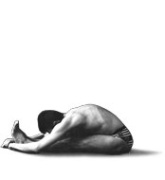 1. Pashimottanasana is one of the variants of translation – «buttocks stretching». B.L. Smirnov treats P. as a «position with back stretching» since "pashima" means the back (western) surface of the body (in India, as a rule, one practices yoga and offers up prayers face to the east). It is sometimes written Paschimottanasana. We find in «Hatha Yoga Pradipika»:
1. Pashimottanasana is one of the variants of translation – «buttocks stretching». B.L. Smirnov treats P. as a «position with back stretching» since "pashima" means the back (western) surface of the body (in India, as a rule, one practices yoga and offers up prayers face to the east). It is sometimes written Paschimottanasana. We find in «Hatha Yoga Pradipika»:
28. Stretch out both legs and grip the big toes, then you must lay your head upon the knees. This is Pashimottanasana.
29. Being the best … , Pashimottanasana causes the breath to flow through Sushumna, fans the fire of stomach, cleans superfluous deposits in the loin, and removes all ailments.
"Gheranda Samhita": («The way to Shiva», p. 18)
2.22. Stretch out legs on the floor as sticks. Lay hands on both legs and keep carefully the feet ends. It is Pashimottanasana.
Svami Yogeshvaranand in «First Steps to Higher Yoga» results 12 variants of P., D. Brahmachari in «Yogasana Vijnyana» demonstrates P. on the contrary extremely briefly and with minimal comments.
In «Enlightenment … » of B.K.S. Iyengar, P. and its modification take an important place; it is offered for elimination of a set of troubles, including obliterating endarteritis, but the necessary vascular effect arises only at maximal turn of the basin in joints of hips.
It is possible to translate P. as «buttocks stretching». The purpose of the pose is to fold in the loin similar to a sheet of paper; the trunk at the same time is laid on the straight legs. One can see the canonical form in photo series «Enlightenment on Yoga» (№160).
In the completed variant of P. the back represents more or less a flat arch. The face lies down on legs behind knees, at the same time the loin makes with the floor an angle of no more than forty-five degrees, the acuter it is the more perfect the pose is. However, the individual configuration of P. depends exclusively on the structure and the form of the thorax; if it has a barrel form, the angulation of the loin with the floor grows, if a flatness – decreases.
In poor-quality illustrations knees and stops in P. are sprawled to sides, why legs get the kind of a distinctive extended rhombus, departing greatly from the floor in popliteal area. Certainly, such position is incorrect.
Feet in P. should be:
a). closely shifted together;
b). It is not necessary to pull the toe as gymnasts do it, reducing thereby the stretching of the posterior surface, one should pull fingers to oneself and heels forward that soles were more or less perpendicular to the floor, at the same time the posterior surface of hips adjoins to it as much as possible.
c). Soles form a united plane, instead of moving to each other, similarly to palms of the clasped hands. On the contrary, at a competent performing the pose, internal edges of soles "are pushed out" somewhat forward and external ones are slightly unbent back and outside.
When an inflexible person sits down on the floor with the trunk, perpendicular to the floor, his legs are already strained. The work begins that you, sitting straight, release them inside, especially muscles of hips, simultaneously relaxing consciousness. The legs should remain on the floor in the "unfastened" condition as though they were independent from the body.
And if the relaxation has arisen, the trunk itself will start to flow down forward and downwards. If to do P. rightly, the legs lay on the floor straight as sticks; they simply do not «want» to bend at the knees. There is such sensation, that the bones literally rest against hip joints, and the back stretches. In the third approach the trunk lies down on legs, and there are no sensations; it is even more convenient to stay in the final form than to enter into it.
Position of the head. Texts demand, that in all poses which have not been connected to special bending of the backbone, it was kept as straight as it is possible. Therefore in any stage of P., one should not hang one's head.
The back. If it is too strongly hunched up, so as the Tantra asserts, the practicing receives a "puncture" in area of Manipur Chakra and loses energy. I cannot confirm or deny the given statement, but work of breathing and cardiac performance at the back bent like a wheel, is certainly complicated.
Eyes. They should be closed whenever possible (in all poses where it is feasible), however, someone can get relaxation including the mental one, more easy exactly with open eyes, but it is a specific feature. There is possible also the third, intermediate position of eyes – semienclosed.
If the initial level of flexibility does not allow to get feet with hands, it is necessary to throw above them a thong, a scarf – all kinds of things that it was possible, having taken it, to sit rather freely. If the trunk makes with legs a blunt angle, attempts of performing P. are inexpedient, it is necessary to replace it by Uttanasana (№ 47, «Enlightenment on Yoga»). To leave sensations, one can lean with hands not on the floor, but for instance – on a pile of books.
P. can therapeutically influence on pathological lumbar saddle backs; in a complex with twisting and backwards deflections, this pose eliminates lumbagos, radiculitises, and favors prevention of miscarriage by women (functions of organs of the reproductive sphere depend on the state of lumbar spine).
The back stiffness disappears, the posterior surface of legs stretches, the body becomes flexible. Pashimottanasana stimulates work of bowels, stomach, and abdominal organs.
Contraindications: excess weight, abdomen fatty layer, pregnancy over three months, and intervertebral and inguinal hernia.
 2. Vrikshasana – "tree" pose. Standing on one leg, take the foot of the second leg, bent at the knee, and place it on the internal surface of the hip of the weight-bearing foot, toes downwards – the heel upwards. The heel should be placed closely to the pubic bone, and the foot itself and the surface of the lower leg make a unified plane with the forward surface of the hip of the weight-bearing foot whose muscles should be strained up to such degree that the foot "did not sink" in them, but leaned against the firm surface. The weight-bearing foot is straight at the knee, the patella is tightened up. The knee of the bent leg does not deviate forward; it is completely turned sideways, in the trunk plane. Hands are stretched upwards, completely straightened at the elbows so that the internal surface of forearms touches ears. Palms of hands face together. The body is straightened as a string upwards, but without an appreciable tension and an arching in the loin. The attention should be turned on immovability (silence) in the weight-bearing foot. When it becomes full, one can close eyes, but it will not be soon, and at the beginning it is possible to fix В., having caught a look for any point in the interior. If the abdomen is completely weakened, so breathing is formed in an especial way, there comes comfort. It is so conveniently to stand, that one would not leave the pose. It becomes so convenient, as the column pose in qigong.
2. Vrikshasana – "tree" pose. Standing on one leg, take the foot of the second leg, bent at the knee, and place it on the internal surface of the hip of the weight-bearing foot, toes downwards – the heel upwards. The heel should be placed closely to the pubic bone, and the foot itself and the surface of the lower leg make a unified plane with the forward surface of the hip of the weight-bearing foot whose muscles should be strained up to such degree that the foot "did not sink" in them, but leaned against the firm surface. The weight-bearing foot is straight at the knee, the patella is tightened up. The knee of the bent leg does not deviate forward; it is completely turned sideways, in the trunk plane. Hands are stretched upwards, completely straightened at the elbows so that the internal surface of forearms touches ears. Palms of hands face together. The body is straightened as a string upwards, but without an appreciable tension and an arching in the loin. The attention should be turned on immovability (silence) in the weight-bearing foot. When it becomes full, one can close eyes, but it will not be soon, and at the beginning it is possible to fix В., having caught a look for any point in the interior. If the abdomen is completely weakened, so breathing is formed in an especial way, there comes comfort. It is so conveniently to stand, that one would not leave the pose. It becomes so convenient, as the column pose in qigong.
As well as all "standing" poses, В. promotes elimination of flat-footedness; the carriage is corrected, the stiffness of humeral joints disappears. There are practically no contraindications.
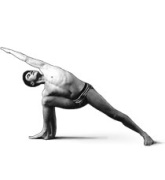 3. Utthita Trikonasana – a «right triangle». It is necessary to detail the starting position in this pose. The matter is that proportions of the body and the length of extremities of people are different, just as growth and constitution. At once there is a question: what is width of legs placing in UT in each concrete case? It is defined so: at an inclination sideways the hand, lowered perpendicularly downwards, should be located in the middle of the same leg, on its segment from the knee up to the ankle-joint. Or so: the hand touches the floor on the center of horizontal projection of the mentioned segment.
3. Utthita Trikonasana – a «right triangle». It is necessary to detail the starting position in this pose. The matter is that proportions of the body and the length of extremities of people are different, just as growth and constitution. At once there is a question: what is width of legs placing in UT in each concrete case? It is defined so: at an inclination sideways the hand, lowered perpendicularly downwards, should be located in the middle of the same leg, on its segment from the knee up to the ankle-joint. Or so: the hand touches the floor on the center of horizontal projection of the mentioned segment.
I do not recommend at a jump as it is demanded at school of Iyengar, to take a starting position in "standing" poses, no less than to leave them so. Sudden movements excite, and our problem is quieting, therefore the enter into asana and leaving it should be slow, weakened and soft.
Position of feet. In all "standing" positions feet are always oriented so that the foot, to which the inclination goes (or to whose side one lunges), would be located in the plane of legs and trunk, and directed sideways, in parallel to the wall when you stay to it with your back. Another foot always forms with the first an angle from forty-five up to approximately seventy degrees. During performance of any "standing" pose the soles of both feet should closely adjoin the floor.
Legs in UT should be straight at the knees, patellae tightened upwards. The trunk, having lowered sideways, is placed strictly in the vertical plane, what in the beginning should be fixed by touching the wall by both shoulder-blades.
So, performing UT, it is necessary to stand so that the foot to which one should bend, was located at the distance of 10-15 cm from the wall and was parallel to it. Then the heel of the opposite leg – at the turn up to the necessary angle – will touch this plane. Having placed legs for the necessary width, I start to lower with exhalation the trunk sideways, for instance, to the right. At the same times, shoulder-blades, especially the upper, do not lose contact to the wall. It is necessary to sink so until a resistance appears in body sides or in the leg. As soon as it has arisen and sensations – no matter where! – became obvious, I should, resting the right hand against the right leg (with shoulder-blades pressed to the wall) distribute on it a part of the trunk weight and remain in this position. Legs are straight at the knees and stretched (without a superfluous tension!), the trunk is weakened! The upper hand is lifted in zenith; the lower is dropped in nadir. That is, though it rests against the leg or the floor, but it remains to be perpendicular to it. Simultaneously I turn my head to the left so in order to look without a special tension in the neck (and with the closed eyes to keep simply the head rotation) at the thumb of the left hand which is above.
As far as one gets accustomed, it is necessary to move away from the wall; for the control it is possible only hardly to touch it with shoulder-blades; subsequently asanas are carried out unsupported.
One should enter UT on exhalation, breathe further freely and raise on inhalation in the starting position so that speed of bending – extension did not break breathing. An exhalation during bending, inhalation – and breathing is quiet and weakened, but I am already in the pose. At the same time the pattern of breathing and its parameters (volume, depth of inhalation-exhalation, their correlation, frequency, etc.) have simultaneously changed with configuration of the body, became different, inherent to the form of exactly this pose. But, on the other hand, respiratory process has remained the same natural and free!
If to observe such approach, muscles of the abdomen and the diaphragm in asanas completely relax what provides easiness and comfort in the "pluck". It is an important sign, indicating that intra-abdominal and intrathoracic pressure does not grow.
Here is a fragment of Ambu’s book «Years and Days of Madras»):
«In yoga gymnastics», – Ambu explains, «a huge role if not the main, plays breathing and blood circulation. Now I can control both that and another. I know, how blood circulates, what vessels are filled, and I can feel movement of blood in them».
He easily rises from the mat, comes up to the window and closes it.
«I want to show you something. And movement of the air will prevent me. Therefore I have closed the window. Elementary exercises of yoga are, probably, known to you».
I nod my agreement.
«I shall show you what one can make on their basis».
(Then there is a text mentioned in the chapter «Why is exactly it?») and further: «His flexible body with the smooth elastic skin was completely dry. I have not noticed a bead of sweat.
«Now I need half an hour in order to restore the respiratory rhythm», – he has told.
«But you even do not grasp for breath», I have noticed.
«The respiratory rhythm disturbance is imperceptible for an inexperienced person».
Thus, showing a cascade of improbable poses, Ambu (By the way, he had acted in the known documentary film «The Indian Yogins: Who Are They?») has NOT sweated at all, and it was not possible to notice any disturbances of the respiratory rhythm! Hence it follows: the control of breath and blood circulation about which he speaks, it is nothing else as preservation of their naturalness and rest!
To leave competently UT one needs, doing the next exhalation, smoothly, not straining to rise into the starting position on a bit prolonged inspiration, then – an arbitrary exhalation, an inspiration – and I have again returned to the former respiratory pattern, as if nothing has ever been!
But if the breathing had been upset or had become complicated, it means that the following mistakes were separately or in different combinations made:
– A too fast enter into asana or leaving it;
– Necessary time lag is exceeded;
– Muscles are too much strained;
– The form is too complicated.
The most difficult for beginners is carrying out asanas without "touch" of themselves. It should be so: the body operates, and ego is aloof observing. To perform a pose qualitatively means to make it exactly so as far as it turns today out, without any diligence, desire, and impatience. Yoga, as well as policy, is art of the possible.
Contraindications for U.T. are not numerous: monthlies of women, an exacerbation of disorders or diseases of internal organs.
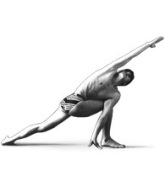 4. Parivritta Trikonasana is a pose of the "turned triangle". It is also more favorable to master it at the wall, having gotten up face to it. Bend then with an exhalation, twisting the shoulder girdle at an angle of 180 degrees, and having touched in a result the wall with both shoulder-blades. Put then the palm of the left hand on the floor at the lateral side of the right foot so that tips of toes and fingers were at one level. If it is impossible to get at the floor, one should lean with the left hand against the right leg, a pile of underlying books or a special prop in the shape of a "brick". At the same time shoulder-blades and shoulders are as far as possible pressed to the wall, the right hand is brought along it into the zenith. In the beginning one should stand how it turns out, with the not completely screwed up shoulder girdle, hugging the support with the left shoulder.
4. Parivritta Trikonasana is a pose of the "turned triangle". It is also more favorable to master it at the wall, having gotten up face to it. Bend then with an exhalation, twisting the shoulder girdle at an angle of 180 degrees, and having touched in a result the wall with both shoulder-blades. Put then the palm of the left hand on the floor at the lateral side of the right foot so that tips of toes and fingers were at one level. If it is impossible to get at the floor, one should lean with the left hand against the right leg, a pile of underlying books or a special prop in the shape of a "brick". At the same time shoulder-blades and shoulders are as far as possible pressed to the wall, the right hand is brought along it into the zenith. In the beginning one should stand how it turns out, with the not completely screwed up shoulder girdle, hugging the support with the left shoulder.
One should enter into P.T. as usually, slowly, and with expiration. Make then sure that the effort, arisen from twisting and at the support on the hand, did not disturb breathing. The stomach is twisted, absolutely weakened, and touches the interior surface of the hip of the right leg. Ideally, it is pressed to it so that there was no space. The face is turned upwards, as well as in U.T.; eye fixes the thumb of the right hand. However, I shall repeat, eyes in asanas should whenever possible be closed.
During performance of "standing" asanas it is possible to apply a so-called half principle. His essence consists in the following: having entered into the pose, you spend half-time in the draft, preliminary form, releasing respiration and relaxing. When the body "flew", became plastic, one should simply haul in the "slack" of form.
Position of feet in both Т. is identical; the leg, aside which the inclination goes on, is a bit more loaded, but the work of hip joints of a hip is various in "direct" and "inverted" Т.
Effect of mastering "triangles": they are useful at scolioses and arthritises of the lower back, shoulder joints, weak dislocation of vertebra, sciatica, flat-footedness of all kinds, and superacidity. These poses are successfully applied to elimination of aftereffects of poliomyelitis and in some cases help in cerebral spastic infantile paralysis, but only at moderately expressed residual phenomena and under the direction of a skilled expert.
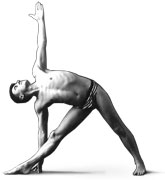 5. Utthita Parsvakonasana is a «right lateral angle». This pose belongs to a variety of "standing" asanas with a lunge when one leg remains straight, and another is bent at the knee under a right angle. At the same time the upper part of its hip is strictly parallel to the floor, and the site from the knee up to the lower leg is perpendicular. The position of feet is standard. The trunk is inclined in an aside to lunge, being stacked on the side of surface of the hip which is parallel to the floor. Both shoulder-blades touch the wall that is the thorax is turned in the plane of legs. The lower hand placed outside, behind the leg, leans against the floor with palm, fingers or fist. As far as the body side lies down on the hip of the bent leg, closely or up to the contact it depends on the length of arms.
5. Utthita Parsvakonasana is a «right lateral angle». This pose belongs to a variety of "standing" asanas with a lunge when one leg remains straight, and another is bent at the knee under a right angle. At the same time the upper part of its hip is strictly parallel to the floor, and the site from the knee up to the lower leg is perpendicular. The position of feet is standard. The trunk is inclined in an aside to lunge, being stacked on the side of surface of the hip which is parallel to the floor. Both shoulder-blades touch the wall that is the thorax is turned in the plane of legs. The lower hand placed outside, behind the leg, leans against the floor with palm, fingers or fist. As far as the body side lies down on the hip of the bent leg, closely or up to the contact it depends on the length of arms.
The lunge is kept by effort of muscles of the thigh of the bent leg. Those who possess a good flexibility of joints sometimes sink too downwards; then a sharp angle is formed at the knee. At the same time muscles of the bent leg are off, the weight of the body completely comes on the knee joint – it is a mistake. "Standing" poses are not intended to avoid useful muscular work, but on the contrary – to concentrate it where it is necessary. In asanas with a lunge there is a small, but efficient cunning about which Faec Biria has once told: In order that the load, experienced by muscles of legs, might not especially "get" into consciousness, at lunge it is possible to observe so-called "hinch". What is this?
If to have a look on the foot of a freely standing leg, so where is the instep, nearer to the inside, the sinew stretching up along the shinbone, stands noticeably out. Hinch (inch means in translation "inch", 2,5 centimeters) is a site of the given sinew from the instep up to that place where the leg becomes vertical, about three centimeters (about inch) of its lengths. And if we with a small effort in the instep lift toes, so hinch stands out, becomes visible, and "iron". Work of muscles of the hip of the bent leg almost ceases to be felt what allows to hold asana freely. But it does not mean that there is no effort at all! If, using "hinch", to overdo asana with lunge, not having received even sensations, the breathing will be lost already after finishing the pose. Therefore one should reasonably use the mentioned method.
The hand disposed from the top is stretched and touches also the wall together with the shoulder-blade, being as though a continuation of the line of the top side. One must, having turned the head, look upwards from under the hand. When I say «to look upwards», it is not necessarily to do it turning out eyes and the neck, one must simply turn the head as far as possible without tension and trouble.
There are no contraindications to the pose, except for the general ones, stated in chapter "Asana". Effect is the same as from "triangles". The inverted variant of U.P. delivers to the beginners unforgettable sensations and is called
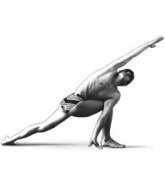 6. Parivritta Parsvakonasana is a «pose of the twisted lateral triangle».
6. Parivritta Parsvakonasana is a «pose of the twisted lateral triangle».
According to the difficulty of performance, Iyengar had given Padmasana factor "four", and P.P. – "eight", already this single fact says that this pose is not simple. It is better to begin it, having risen to the knee, let us suppose, the right one, and having performed the standard lunge with the left leg. Turn then with an exhalation the trunk and put the right hand behind the left leg, which is in the lunge, from its external site so that the hand was parallel to the leg part from the knee up to the ankle. This hand rests against the floor with the palm or fingers – as far as proportions and deposits on abdominal muscles allow.
Then it is necessary, relaxing, but without special effort (if it is required a special one, it means you simply need not do it) to screw up the shoulder girdle so that the left shoulder got further, upwards. When it passes the top point of its "trajectory" in this position, so actually after a turn of more than hundred eighty degrees it will already move downwards and back. The left hand should be put behind the back. Observing freedom of breathing and relaxation, one should remain so half of time of endurance. Tear then away the right knee, stretch the leg and put it on the floor with all sole. Take simultaneously out the left hand from behind the back and stretch it forward and upwards so that it would continue the line of the side. Breathe freely, though the respiratory volume will be rather limited. The stomach is absolutely weakened. The body is twisted in the girdle, but the effort from preservation of the form does not strike to face with heat and with tension in the pit of your stomach. Breathing and the stomach as far as it is possible must be kept weakened all time of endurance. When it has ended, it is necessary with an inhalation to sink on the right knee and to untwist slowly the body into the starting position.
For the beginners, P.P. is, as a rule, really difficult. At first it is better to perform it with a support, not extending forward the hand which is above, but leaning by it against any nearby subjects. If the leg straightened at the knee does not step with a full foot, it is possible in the beginning to lean it against the tiptoe. The main problem consists in keeping lunge as a right angle (instead of blunt or sharp), not too distorted from the plane and also in keeping the hand behind the knee of the opposite leg.
Though for nonflexible people P.P. is a hard one, as a result of regular practice it becomes – as well as all "standing" – a favorite pose.
Contraindications: loin problems, acute states of internal organs, intestinal neurosis, inguinal hernia. The pose is rather useful at indigestion and a bad state of abdominal organs. By the way, a regular practicing "standing" poses completely eliminates constipations.
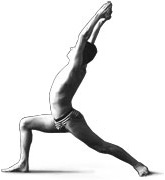 7. Virabhadrasana I is a «vira hero pose». I would recommend beginners to master at first its preliminary stage (№13 «Enlightenment … ») so far as even it happens to be the problem one because of a bad mobility of the loin and hip joints. The pose is extremely simple, though there is a "but": the pelvis in it must perpendicularly be turned to the plane of legs. Or so: the straight line, drawn conditionally through the femoral heads of both joints and also the thorax after the turn should be perpendicular to the plane which is formed by legs.
7. Virabhadrasana I is a «vira hero pose». I would recommend beginners to master at first its preliminary stage (№13 «Enlightenment … ») so far as even it happens to be the problem one because of a bad mobility of the loin and hip joints. The pose is extremely simple, though there is a "but": the pelvis in it must perpendicularly be turned to the plane of legs. Or so: the straight line, drawn conditionally through the femoral heads of both joints and also the thorax after the turn should be perpendicular to the plane which is formed by legs.
At the same time that of them which is from behind, should be straight at the knee and adjoin closely, with the whole sole to the floor. The back in the loin is moderately sagged. After mastering the given position it is possible to try the final form of V. One should not fix it for a long time as the heart load is great enough. There are no special contraindications, those who has problems with radiculitis or lumbago should perform the asana slowly and lean the hand of the same name against the knee of the leg being in lunge, in order to unload the loin. At acute states of the back the pose is forbidden. As a result of practice of this pose, the thorax gets elasticity and becomes, as they say in Hatha Yoga, opened.
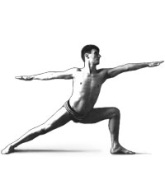 8. Virabhadrasana II is a variant of the same «hero pose». According to its form this asana is elementary; one needs only to make a standard lunge, to follow "hinch" and to relax the abdomen, keeping the naturalness of breathing. The trunk is turned in the plane of the legs; the backbone is perpendicular to the floor. The muscles of thigh being in lunge work actively. What can give such a by all appearances most elementary pose? In daily life the person should frequently stand up and sit down, therefore his legs constantly pass through an analogous form, but it lasts fractions of a second. If to transform it in asana, load on muscles, ligaments and joints become manyfold stronger. This temporal factor of strengthening, by the way, causes the strongest influence of all poses of yoga (and "standing" particularly) on the body, CNS, and ANS.
8. Virabhadrasana II is a variant of the same «hero pose». According to its form this asana is elementary; one needs only to make a standard lunge, to follow "hinch" and to relax the abdomen, keeping the naturalness of breathing. The trunk is turned in the plane of the legs; the backbone is perpendicular to the floor. The muscles of thigh being in lunge work actively. What can give such a by all appearances most elementary pose? In daily life the person should frequently stand up and sit down, therefore his legs constantly pass through an analogous form, but it lasts fractions of a second. If to transform it in asana, load on muscles, ligaments and joints become manyfold stronger. This temporal factor of strengthening, by the way, causes the strongest influence of all poses of yoga (and "standing" particularly) on the body, CNS, and ANS.
Once a lady, who had read some time and somewhere that the purpose of Hatha Yoga is development of flexibility, addressed me. Having devoted to it long years, she bent wonderfully, however has earned steady asthenia with the lowered blood pressure, fatigability, hypererethism, and sleeplessness. Only after three months of regular practicing "standing" poses her face has turned pink, and movements across Moscow have ceased to be a heroic deed.
Each person possesses an individual spectrum of psychophysical abilities; activity, force, energy, movement predominate by someone, but they are lacking flexibility, the qualitative rest is almost inaccessible to such people. They are magnificent workers, but relax badly, what leads to the premature systemic deterioration, in this case practice of asanas should be focused more on relaxation and development of flexibility, power poses should provide only preservation of the necessary muscular tone.
The predominance just of power poses is useful for people with the diminished energetics (more often it concerns women) that allows to receive necessary quality of a muscular corset. Practice adequate to the initial state and constructed competently gives in physical aspect everyone exactly what does not suffice for him.
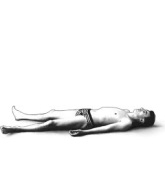 9. Shavasana, the «dead body pose», demands a detailed explanation as its correct performance provides at times the greater part of practicing effect, and the incorrect one (as well as full absence of Sh.) is capable to damage.
9. Shavasana, the «dead body pose», demands a detailed explanation as its correct performance provides at times the greater part of practicing effect, and the incorrect one (as well as full absence of Sh.) is capable to damage.
If the technology is observed, the body, by all appearances, does not especially get tired. What is Sh. then necessary for?
In the eightieth of the last century I happened to train in yoga a master of sports in acrobatics. Having warmed up, he carried out very complex poses, but could not fix them! It was all right to bend – to unbend, but when I asked him to keep the extreme form, he refused saying: «I have such impression that the head will burst, as though it is brimming over …
In the seventh chapter is told: « … In the cortex the new dominant foci of specific excitation are formed which inhibit, disable or "erase" already available foci». The point of Sh. is that to remove this unusual excitation, having left the system restored and cleared.
In process of adaptation, time of Sh. will decrease, it becomes qualitative other, but to carry it out after practicing is always necessary. If beginners ignore Sh. after practicing they can receive a nasty state of health, neurotization, sleeplessness, and other amenities.
What should happen in SH.? If you honestly lay fifteen minutes, with the completely relaxed body, but the consciousness transparent as a bit of glass, "chewing" involuntarily ideas, expecting with melancholy when the damned quarter of hour terminates, it is not Shavasana, but as Venichka Erofeev had said a soul killing and heart destruction.
Here is one of sequences of SH. (as a matter of fact there can be a great number of them). Observing necessary conditions (silence, heat, closed eyes, etc.), one should relax sequentially: the neck, throat, lower jaw… Cheeks, cheekbones, lips… The submaxillary muscle, chin, upper lip… The corners of the mouth, tongue, lower lip, nose… Feel that the skin of the nose at the same time as though gets smoothed out, there is some latent movement in it, pricking, pressure sense, weight of heat which flows into depth… Release eyes inside… Relax eyelids, eyebrows… In the skin of eyebrows there is weight, heat, as though they flow down to temples…. Relax the forehead… Feel the skin of the forehead… Feel pressure in it, pricking, heat, as if someone has put a hot palm on the forehead… Relax temples… Feel the skin of all head and a pleasant light weight in it, covering heat… Relax the nape, neck, throat…. (Thus, the circle "head-face-neck" has closed up, now we move on to the trunk).
Relax hands, feel heat and weight in hands… Hands grow heavy… Feel the skin of palms; listen attentively to sensations in them… As soon as you have paid attention to palms, at once there is a vague movement in their center… Pricking… Weight… Hot gooseflesh appears in the skin of palms, a pleasant, pressing heat… Palms are hot… Heat spills on them and starts to flow down to wrists… Relax wrists… Elbows… Forearms… Release shoulders, shoulder-blades, collar bones… Relax the back, body sides… The stomach, loin… Buttocks, hips… Release knees, calves… Ankle joints, feet… Feel the skin of soles… As well as in palms, there is pressure, prickling, heat in them… Equalize soles in heat with palms…
This sequence can be recorded to the audiocassette and listened to after practice. It is desirable that the voice would not be your own. It is conditioned by the fact that it is only in part familiar to the subject as it has never been perceived from side. At practicing Nidra or SH., your own voice starts process of identification (recognition) which does not allow consciousness to relax properly.
Carrying out instructions, one should not duplicate them mentally; there is no need in mediators between the beam of attention having illuminated some site of the body, and the response which has arisen in the body – feeling of weight, heat, brimming, etc. Relaxing, we move our attention on the body, but there is no need to do it so, as if we move stones.
Heat and weight arise simultaneously with the muscular relaxation, the body gradually goes out of perception, and consciousness itself simultaneously starts "to thaw". By then, when the relaxation "has completely flooded" organism, only one watch area remains from consciousness. Notice, the point is not about falling asleep, it just should not be! In the beginning of chapter "Asana" it was in detail spoken about stages of inhibition, Shavasana is actually a strongly simplified variant of Nidra: the mental relaxation is caused by means of the muscular one, and altered state of consciousness migrates between sleep and wakefulness. If SH. takes place in a usual condition of mind, it means that it simply has not turned out well.
It is not easy for the person of the West to master relaxation, but sometimes only that solves the majority of problems. Those who cannot master SH. have, as a rule, a certain point of contracture in the face or the body latent from perception, exactly it keeps consciousness in the habitual tone. This point can be everything; if we could reveal and release it, the relaxation is provided.
In the head and facial region there are muscles which, not participating in asanas, nevertheless, influence strongly on the general muscular tone and in any case should consciously be relaxed. These are two ligaments going from the nape downwards along the back surface of the neck, submaxillary and frontal muscles. And one thing more – eyes, if they "are not released", it is impossible to relax consciousness. The majority of people do not suspect that their internal tension is reflected in the state of eyes: if during practicing asanas with closed eyelids eyeballs are unceasingly move, it tells about a steady internal anxiety.
At partial fading of consciousness, in SH. some phenomena, well-known in the autosuggestive training, can be shown: the feeling of soaring, flight, enlargement of separate body parts, chorea, illusion of change of form, etc.; all this is allowable and should not puzzle anybody. The depth of relaxation is always variable, it has a wavy, oscillatory character; consciousness sometimes leaves, sometimes comes back, it is normal. Those who are seeing images should not be puzzled by their randomness if before internal sight it flashes not clear what, it means the mental relaxation has gone.
If in attempts to perform Nidra every time one get sensation of overturning back, dizziness or nausea, that indicates cerebral problems, one should immediately make tomography or EEG.
When sequence of SH. has been remembered, it is possible to do it independently, not pronouncing to yourself, but simply moving attention on the body.
Requirements to performance of SH.: position of lying on the back, legs shoulder width apart. Hands are drawn aside from the body so in order not to touch sides, armpits are opened. Turn hands with palms upwards, as far as it is possible and comfortable. To prevent light at performance of SH. in the afternoon on should put something on eyes. Clothing is casuals, better not synthetic materials. Watch, glasses, rings, brooches, necklaces, chains, metal, plastic, glass – one should remove all this for the period of relaxation and practice. Only wooden bijouterie is allowable, but they should not disturb. The silence, absence of sharp sounds, and smells is required.
The presence of optimum temperature of the air in premises for practicing yoga is purely Russian problem. Performance of asanas at temperature of lower than +20°С prevents the muscular relaxation and is for beginners unacceptable. If it is impossible to heat up the air, in SH. one should be covered by a warm plaid, to put on socks, etc. One should not lay on a cold or sagging surface; the back should be straight.
The individual time of SH. is formed gradually, after its end hypotensive patients can feel shivery, in this case it is necessary to move vigorously.
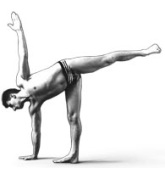 10. Ardha Chandrasana is a «half moon pose»; there are no special contraindications. One should perform it slowly, the supporting foot as well as that is located without backing in parallel to the floor, should be stretched and straight. The trunk and pelvis are turned (as far as it is possible) in parallel to the wall, as well as the foot of the supporting leg. In accordance with your desire you can keep the pose one minute to each side or more if it is comfortable.
10. Ardha Chandrasana is a «half moon pose»; there are no special contraindications. One should perform it slowly, the supporting foot as well as that is located without backing in parallel to the floor, should be stretched and straight. The trunk and pelvis are turned (as far as it is possible) in parallel to the wall, as well as the foot of the supporting leg. In accordance with your desire you can keep the pose one minute to each side or more if it is comfortable.
Speaking of comfort, some people (for example, former drug addicts) hope that kef from yoga can be replaced by that from drugs. As everyone is well aware, the organism produces endogenous ethanol (though in very small quantity), and during a powerful physical overload also endorphins, working similarly to drugs. Once I had met a person having read in muddy reprints that asanas should bring pleasure. And he had caught this pleasure! With the help of some own techniques he went into ecstasies and in such condition could, not remembering himself, "drive" asanas four, six, eight hours on end. His basic achievements were that he has not completely crippled the body and has not gone mad. A strong organism was given by nature to this guy, but to the moment of our meeting a little had remained from his health, and the kef hunter was not as far back as fifty. He repeatedly had traumatized joints and ligaments, not feeling pain, and besides degraded as the person because of infinite euphoria. Nevertheless, siddhas, arisen during its "sadhana", made the strongest destabilizing influence on neurotics who had communicated with him.
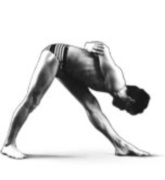 11. Parsvottanasana is a "head – knee" pose.
11. Parsvottanasana is a "head – knee" pose.
Except for hypertension and retinal detachment there are no contraindications. Bring your feet regularly. Having turned to some side (we shall tell, the left leg is ahead), incline on exhale forward slowly and downwards, "being aimed" on the leg not by the side, but by the middle of the thorax. The trunk should not be warped, remaining perpendicular to the planes of legs. One should hang freely down, observing breathing in nostrils and relaxing the stomach. If there is a trouble under the knee, to which side the inclination is performed, one should lean against the floor with one or both hands. The point is that to extend the trunk along the leg similarly to Pashimottanasana, to lie down on it with the thorax, the stomach and to relax. It is possible to leave the pose on an inhale. As a result the trunk "spreads" on the leg and the chin touches it much below the knee. P., as well as all "standing" poses, is performed to both sides.
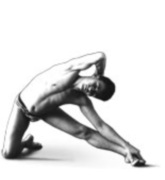 12. Parighasana is a «pose of a bar used for closing a gate». There are two contraindications: groin hernia and intercostal neuralgia. A starting position: the knee of one leg stands on the floor. At the same time its hip together with the trunk is in the vertical position. The opposite leg is thrusted out sideways, remaining straight at the knee; its foot leans obliquely against the floor. Lower the same hand on the leg out-stretched at the knee, lift the second upwards. Keeping the trunk in the plane of legs, with the minimal curvature of the pelvis, lower it to the side of the straight leg. The same hand slides on this leg, to its foot. Other hand lowers from the top position on the same leg, out-stretched at the knee and the hand, sliding on it. As a result the body gets a strange form which, nevertheless, will involve muscles and ligaments of the lower part of the back and pelvic joints more than ever and nowhere. One should strictly observe the full relaxation of the body and breathing at entry, going out, and during endurance of the pose.
12. Parighasana is a «pose of a bar used for closing a gate». There are two contraindications: groin hernia and intercostal neuralgia. A starting position: the knee of one leg stands on the floor. At the same time its hip together with the trunk is in the vertical position. The opposite leg is thrusted out sideways, remaining straight at the knee; its foot leans obliquely against the floor. Lower the same hand on the leg out-stretched at the knee, lift the second upwards. Keeping the trunk in the plane of legs, with the minimal curvature of the pelvis, lower it to the side of the straight leg. The same hand slides on this leg, to its foot. Other hand lowers from the top position on the same leg, out-stretched at the knee and the hand, sliding on it. As a result the body gets a strange form which, nevertheless, will involve muscles and ligaments of the lower part of the back and pelvic joints more than ever and nowhere. One should strictly observe the full relaxation of the body and breathing at entry, going out, and during endurance of the pose.
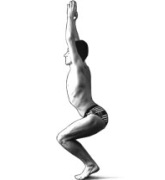 13. Utkatasana is a «keeping energy pose»; there are no contraindications except for problems with the loin. In this pose it is as though we sit down in an imaginary chair in view of that: 1). feet are put together and stand closely on the floor; 2). hands extended and coupled by palms, straight at elbows make a straight line with the back.
13. Utkatasana is a «keeping energy pose»; there are no contraindications except for problems with the loin. In this pose it is as though we sit down in an imaginary chair in view of that: 1). feet are put together and stand closely on the floor; 2). hands extended and coupled by palms, straight at elbows make a straight line with the back.
Especially those whose shoulders are subdued cannot do it so easily. The pose as much as possible loads ankles, buttocks, ankle joint, muscles of hips and the back. The breathing is continuous, the stomach is relaxed.
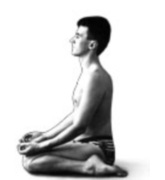 14. Virasana is a «hero pose». The main contra-indication for V. is varix dilatation; in this case maximal time of endurance is not more than a minute; two-three repetitions are allowable.
14. Virasana is a «hero pose». The main contra-indication for V. is varix dilatation; in this case maximal time of endurance is not more than a minute; two-three repetitions are allowable.
The back should be straight both on the site from sacrum to the tail of edge and in cervical-scapular region; the thorax is straightened. The information: when any reference is made to the requirement of the straight back underlined in all texts of yoga (certainly, except for sagging backwards), it does not mean that it is necessary to straighten it completely in literal sense! In norm the backbone has a slight S-shaped form, the superior flexure rounding the back – a kyphosis, a sagging forward in the loin – a lordosis. These are natural saggings; the straight as a stick backbone is a pathology. When they speak that in asanas the back should be straight, it means it is necessary to straighten it so in order to remove excess, superfluous size of kyphosis and/or lordosis, arisen in the given pose – Virasana, Siddhasana, Padmasana, Ardha Matsiendrasana, etc.
If there are no sensations and you succeeded in relaxing, in about five minutes Virasana literally passes into Shavasana. If the posture is incorrect, so by the outcome approximately of the tenth minute there is, as a rule, a short breath and palpitation. At initially stiff ankle joints it is necessary to sit simply on the heels until appearance of sensations. When feet adapt, one should, having taken them on width required for V., put two-three books under «the fifth point» or a not too soft pillow. Despite of efforts to be arranged – on the heels or on the floor between the feet moved apart, it is necessary to look closely into sensations. If they do not go away, but do not also become stronger, it is possible to keep the pose until intensity of them will not start to grow or get an unpleasant nuance. The course of events is standard: to provide form of V. permissible for today with the minimal sensations and to dissolve them with the help of relaxation. If it is impossible, the form should be simplified.
«The fifth point» and wrists of legs should, when the pose is mastered, firmly lie on the floor; feet are strictly oriented by heels upwards, not being turned by the plane either inside or outside, every foot is vertical, as a palm being put on the edge.
If to stay in V. for a long time enough, the body continues somehow to "sink", there is a certain homeopathic movement in joints, though it seems there is already no place to move. Those who cannot in general sit down on the heels can perform in the beginning Ardha Virasana – a half variant, with one straight leg out-stretched forward.
Keeping of V. up to half an hour (without any obvious sensations) in most cases eliminates cluster (beam) headaches and migraine from which any medicines do not relieve. The mechanism of influence of V. is not clear, but the positive result is available.
Those whose muscles of calves prevent to perform V. should turn them outside and to the sides and last of all lower «the fifth point» on the floor.
Virasana gives a magnificent stretch of ankle joints, eliminating (in aggregate with "standing" poses) the tendency to chronic subluxations and also their consequences.
The enormous amplifier of effect of asanas is time; consequences of loss of its control are ambiguous. Here are some examples: once my pupil has felt symptoms of a preinfluenzal condition and was upset, as at temperature of over 37 °C practicing asanas is forbidden. Then he has decided to sit at least in Virasana; and soon, having relaxed, he flaked out. Having come to himself after forty minutes, with surprise he has found out that mild pyrexia and other attributes of flu have fully disappeared – a small happy end.
But another man, who fell asleep in Padmasana at feeling of normal being, has woken up in an hour with cardiac arrhythmia which did not then release him the whole month.
Time is meaningful even for fakirs. In the beginning of 1990’s my friend Roman Amelin has visited the Bihar School of Yoga. In Madras he could observe some Hindu holiday. Among a folk promenade in one of the parks, along with trained elephants, performances of myths and other surprising things, Roman has seen on a mat under a canopy from palm leaves the gilt sculpture of the person in an inconceivable pose. Having marvelled, he has gone further, and already on the way back, having decided once again to look at the statue, he has suddenly understood, having looked more thoroughly that it was a live person! «How much time can he be in such position?» he asked a teenager sitting near. The boy snapped his fingers and, having received a pair of rupees, answered: «Six hours …»
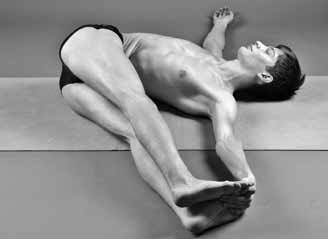 15. Jathara Parivartanasana. This twisting pose has two modifications – legs freely lie on the floor or are keeping by force of muscles without backing near to the floor. Let us consider the first variant which is safe and useful to overweight people and not so flexible ones.
15. Jathara Parivartanasana. This twisting pose has two modifications – legs freely lie on the floor or are keeping by force of muscles without backing near to the floor. Let us consider the first variant which is safe and useful to overweight people and not so flexible ones.
Lie on your back. Lift straight legs upwards to ninety degrees, your arms are in one line with your shoulders. On an exhale, resting them against the floor, lower straight legs sideways under such angle to the trunk that when they lie down on the footplate, it would be possible to catch with the hand of that side to which there is a twisting, at the big toes. If the stretch is not sufficient, it is necessary to put on feet a ring of necessary diameter from a belt and to catch at him with the hand. Thus, it turns out the lying variant of twisting. The given pose, possessing an independent value, can be applied in the event if twisting poses are for any reasons impossible in the sitting position. Moreover, if the loin is subject to radiculitises or lumbagos, it is better to put slowly sideways legs not straight at the knees, but the bent legs, one can straighten them already on the floor.
In the final phase one should freely lie on the back, having weakened the neck and the throat, the face, eyes closed, is turned upwards. The shoulder opposite to legs will in the beginning be in the air, it should not be withdrawn by force downwards; in due course it will be lowered itself. The stomach is completely relaxed.
When both shoulders lie down on the floor, it is necessary to pay attention that the feet are not at one level, the upper is somewhat closer, the lower is farther – the pelvis is warped. Then one can, having relaxed, gradually turn the pelvis till such position when the upper foot locates flush with the lower, and the soles make a single plane. At the same time the opposite shoulder will again tear from the floor, but in due course it will lie down on it in the same way as in the first case. The pose is performed no more than three minutes to each side, the main thing in this position is to relax completely the body and to release breathing. If lumbar spine is a problem, one should not return the legs into the starting position as straight, it is better at first to bend them at the knees, then to lift, having untwisted the body and to lie down in Shavasana.
Hereon, the list of the first day is exhausted; we shall describe poses of the second day (not duplicating those which are included in it from the first).
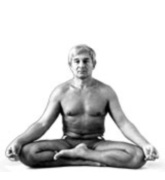 16. Siddhasana, «a perfect pose» (or the pose of siddhas – "ones who are accomplished"), is used including for meditation. Despite of seeming simplicity, a lot of time will pass till ankle joints in it will be turned heels upwards. During a long and persistent practice, S. powerfully influences on the knees and hips. It is not worth trying to reproduce at once a "picture", it is better to do, as it turns out, bringing whenever possible one leg from above another, it will be a cross between Sukhasana (the simplified pose) and Padmasana – the «lotus pose». One should put legs as something like S., so that the discomfort would be minimal; let alone pain or obvious inconvenience. If the knees allow, but the trunk deviates back because of rigidity of the loin or the hip joints, one can lean against the wall to release the body from the superfluous work. For performance of pranayamas and psychotechnics one should stay freely in S. half an hour and more. One can sit with the crossed legs in everyday life, for example, during reading, in front of the TV set, at computer, a musical instrument or at the desk that change of quality would go faster.
16. Siddhasana, «a perfect pose» (or the pose of siddhas – "ones who are accomplished"), is used including for meditation. Despite of seeming simplicity, a lot of time will pass till ankle joints in it will be turned heels upwards. During a long and persistent practice, S. powerfully influences on the knees and hips. It is not worth trying to reproduce at once a "picture", it is better to do, as it turns out, bringing whenever possible one leg from above another, it will be a cross between Sukhasana (the simplified pose) and Padmasana – the «lotus pose». One should put legs as something like S., so that the discomfort would be minimal; let alone pain or obvious inconvenience. If the knees allow, but the trunk deviates back because of rigidity of the loin or the hip joints, one can lean against the wall to release the body from the superfluous work. For performance of pranayamas and psychotechnics one should stay freely in S. half an hour and more. One can sit with the crossed legs in everyday life, for example, during reading, in front of the TV set, at computer, a musical instrument or at the desk that change of quality would go faster.
Diligence, however, is fraught with an overload, hence we have a law: what asanas would not be performed the day before, today there should not be in the body new and unusual sensations, we even are not speaking of pain or trouble! (See "Sensations").
«There is a yoga, carrying away grief, for a person moderate in eating and abstention, moderate in activity and affairs, moderate in sleeping and wakefulness» ("Bhagavad Gita", VI, 17).
In other words, for the period of habituation beginners should remove from everyday life all extreme moments, it is of great importance. An example: some subject has problems with the loin; half a year of practice and it has ceased to remind itself. With the beginning of the summer season the person has vigorously rushed to the holiday village, feeling himself healthy and aimed at feats of labor. After three weeks he appears with a question: «How so, the back again has started to hurt, and the yoga does not help…»
«Let's sort it out», I speak. «How many years did it hurt you? Ten? I see! How much time do you put it into order with the help of yoga? Аhа, the seventh month. When it was healthy yet, how much had you to work on the site till the loin started to fall off? Three hours, well, all right, and how many do you work now? On the average five. Well, for half a year it is hardly possible to correct completely what you have made with your backbone during ten years, loading it at the same time now so that even a healthy back would not be delighted. And meanwhile recovery is occurring, you know it, you feel and have been beforehand warned that overloads should be avoided. As comrade Sukhov had spoke: "Are there any questions? There are not… "»
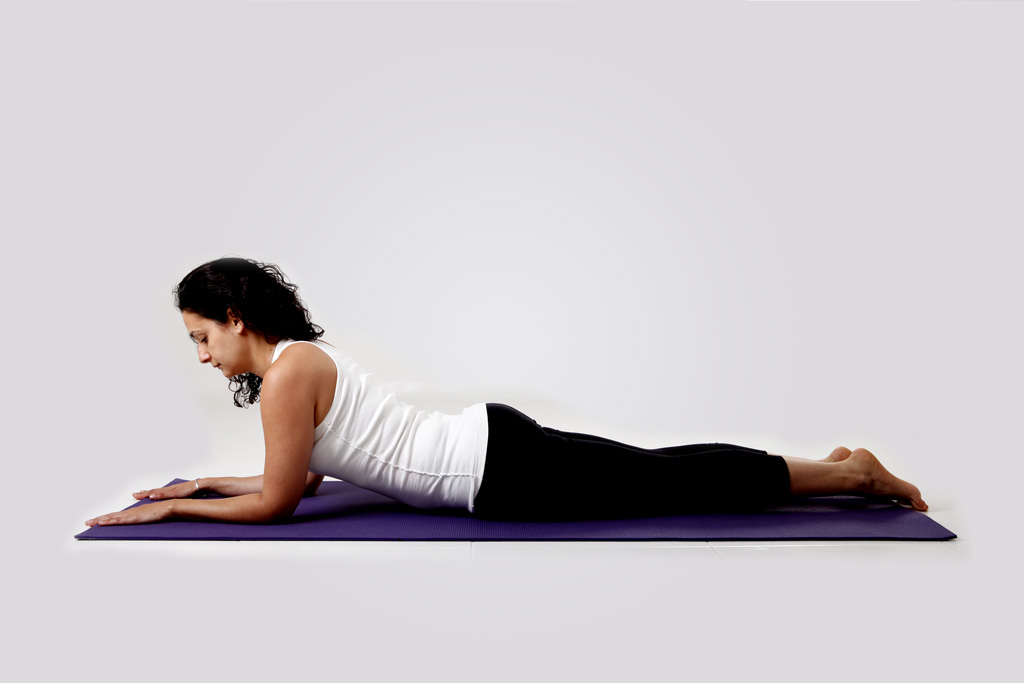 17. Ardha Bhudjangasana or a «half cobra pose». In his work, Iyengar does not give this rather valuable asana, but it can be found in books of his Bulgarian disciples, in particular by Milanov and Borisova («Вправи йогiв», 1972).
17. Ardha Bhudjangasana or a «half cobra pose». In his work, Iyengar does not give this rather valuable asana, but it can be found in books of his Bulgarian disciples, in particular by Milanov and Borisova («Вправи йогiв», 1972).
So, А.B. Lie down on the stomach, on a mat as on a beach, leaning elbows against the floor: arms from hands up to elbows are brought together and vertical, the chin is on fists or palms. From this pleasant position, having stayed in it some time, having relaxed the back, lower your hands, pushed them a little forward, and place them with palms on the floor and with the whole surface – from elbows up to fingertips. At the same time hands are parallel to each other, hands and elbows are on shoulder width. The top part of the trunk is slightly raised, the face is as far as possible turned upwards, and the stomach and lateral edges of the costal arch do not tear away from the floor. The back surface of the forearms where triceps are located makes with the floor an angle of seventy degrees. In such frontal and lateral view the person reminds a sphinx, and it will be position А.B.
One should not sink the neck in shoulders, but pull it out from there, lowering the shoulders downwards. At the same time it is necessary to make with hands a homeopathic in size effort, as though trying "to move" under yourself the supporting plane. Thus, spine kyphosis actively works for extension what in daily occurrence does not happen; and in it there is a special value of А. B. Its regular practice eliminates stoop, improving work of upper lobes of lungs, diaphragm, and heart. Veselin Luchansky who had acted in the film «Indian yogis: who are they?» had brought performance of this asana to the absolute limit when the middle of stomach lays on the floor, and the area of the back from the tail of edges up to the top – including the neck – is completely perpendicular to the floor.
There are no contraindications, except for umbilical and phrenic hernias, and also the large backbone deformations. А.B. possesses a multilateral useful influence.
18. Bhudjangasana is a «full cobra pose». It belongs to the basic asanas, and, being one of the most important, allows a significant development of the form, here is a short cycle of B. Initial phase: bring palms on the floor so that when the trunk is lifted, hands, holding its weight, are located on width of shoulders and are perpendicular to the floor. Now it is necessary to relax the trunk as far as it is possible, the backbone in the rest on hands is hung out as a lace. Time of keeping is a minute or one and a half, depending on sensations. Ideally the pubic bone should touch the floor, but in the beginning it is necessary not to pay your attention to this moment, let it be as it is, one can lean against the upper or even midsection of hips.
The main thing – there should not be any striking sensations; all the more pains in the loin. The pain (trouble) can arise at attempt to relax the loin in full. In that case B. some of the time must be performed without relaxing the back. When the backbone is exercised, the loin will sag without sensations.
Place your feet together with your soles facing upwards and with your big toes touching each other. Relax in this position for a moment and inhale.
Having lowered the upper part of the trunk on the floor, one should after a short pause put the leg on the leg (the foot on the foot), having crossed the legs, and rise again in Bhudjangasana. It is the basic variant; the arms make with the floor an angle of approximately seventy degrees. The partial crossing of the legs gives to the backbone an axial turning, therefore at a scoliosis the difference in sensations will necessarily become apparent; at times the strong, depending on what leg is from above – the right or the left. The backbone in B. is not perpendicular to the floor, at a good flexibility the shoulders get back behind ninety degrees and together with the head come nearer to the heels. This phase is performed during one minute, in two approaches with change of the legs, in the beginning one foot from above, then – another. Muscles of the back are completely relaxed – in contrast to Sarpasana, the "snake" pose, where the trunk is lifted just by them, and the hands only touch the floor.
The following stage of the cycle: laying on your abdomen, lift the trunk upwards without hands, by muscles of the back (time of keeping is about twenty seconds) and further – bring hands forward, not lowering, place them on the floor and perform №19, legs are on width of shoulders, holding is to one minute. All this time breathing remains free and continuous.
Performing this phase of B., it is possible to make simultaneously in it also А.B. It is a curious moment: in one pose we perform another, as a matter of fact, almost not changing position of the trunk and hands, adding only a little bit of physical effort. It is done so: having kept B. about half of the ordered time, it is necessary to press slightly out-stretched hands against the floor, forcing the upper part of the backbone to the extension, and it will be А.B. in Bhudjangasana.
Veselin Luchansky has brought performance of B. to anatomic limits. If in the final phase the line of the back at Iyengar’s practicing makes a sharp angle with the floor already behind the right angle gone in the arching, so the body in performing of Luchansky takes the form of a parabola. The top of the thorax is parallel to the ceiling, the face is completely returned, the vertex is strictly directed downwards and touches practically the back surface of hips. The top of the back from shoulder- blades to base of the neck is parallel to the floor. The support is only on hands which work strongly enough, locating approximately under an angle of forty five degrees to the footplate.
Influence of B. and all its variants on internal organs, especially kidneys, is invaluable; and the degree of flexibility of the backbone is a parameter of physiological age. It is not possible to list all effects of B. in view of their great number; one can only note that potency of men and uterine muscles of women depends on the condition of the lumbar spine.
Contraindications: incarceration and hernias of intervertebral disks, dislocation of vertebrae, hollow back, inguinal hernia, acute stages of radiculitises, lumbagos, monthlies, over eight weeks pregnancy, acute states of organs in the abdominal areas.
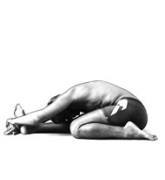 20. Trianga Mukhaikapada Pashimottanasana is a «three-part pose of bending forward». There are no contraindications; it is an original mix of Pashimottanasana with Virasana or Ardha Virasana at bending forward.
20. Trianga Mukhaikapada Pashimottanasana is a «three-part pose of bending forward». There are no contraindications; it is an original mix of Pashimottanasana with Virasana or Ardha Virasana at bending forward.
Sit down on the floor, one leg is in position Virasana, the second is stretched forward.
Then with an exhalation, using the technics of performance of Pashimottanasana, "flow down" slowly the trunk forward and downwards (by midline of the stomach and the thorax) on the straight leg, folding in the middle of the loin. The purpose is to stretch out along this leg and lie completely on it. Position of hands is secondary; one can link them behind the foot of the straight leg or put simply on the floor on the sides.
The knees of both legs are kept together. If Virasana and Pashimottanasana had preliminary been mastered, Т.М.P. goes easily enough, if not – the difficulty of both poses is summarized. If at bending the trunk tends on one side, one should place the opposite (with respect to the bent leg) hand on the floor.
Effect: the combined influence on ligaments, backbone, and especially hip joints.
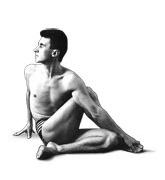 21. Ardha Matsiendrasana is a «half pose of Matsiendra», of the legendary author of Hatha Vidya. Contraindications: acute states of intestine, viscera and loin. The pose gives the back an axial twisting which does not happen in daily occurrence. At regular bending forward, back, and axial twisting, the connective tissue of intervertebral disks, so-called cartilaginous "lenses", start to swell, their blood supply improves, dystrophic displays die away, and the backbone gradually comes in norm.
21. Ardha Matsiendrasana is a «half pose of Matsiendra», of the legendary author of Hatha Vidya. Contraindications: acute states of intestine, viscera and loin. The pose gives the back an axial twisting which does not happen in daily occurrence. At regular bending forward, back, and axial twisting, the connective tissue of intervertebral disks, so-called cartilaginous "lenses", start to swell, their blood supply improves, dystrophic displays die away, and the backbone gradually comes in norm.
Performance of the pose to the right. Bend the left leg at the knee. Sit down conveniently on the lateral surface of the ankle joint of this leg, lying plainly on the floor (or on a bedding, a cushioning – all kinds of things that would not hurt). One need not like in ballet to pull the toe, on the contrary, one should bend the foot so as if it stood on the floor, and sit down on it from above already in its such kind, just on the place called "bonelet". Such position of the foot allows adjusting balance. Transfer the right leg beyond the outside of the left knee lying on the floor and put the foot on the floor. The following has turned out: the left leg bent at the knee lies on the floor; I sit directly on it (on the ankle joint, but not near!), the right is exactly so bent at the knee, but stands on the floor vertically, behind the left hip, outside of it, with the whole foot. The right knee is located before the stomach and the chest.
Turn the trunk farther to the right, bring the left hand beyond the right leg standing vertically (unbending as though it with the hand to the left) and take with the hand of the left arm the knee of the left leg lying on the floor. As a result the left arm on all its length adjoins to outside of the right leg bent at the knee and standing vertically which entirely touches the left side, and its knee is behind the left armpit from the side of the back. Thus, the trunk proved to be twisted to the right side.
One can put the right hand behind the back or rest it against the floor (if it is difficult to keep the trunk without support, or there is a bad balance at the closed eyes). In process of deepening of relaxation and appearance of fluidity one should (choosing "backlash" of the form) move the right shoulder even more to the right, but not to stoop, remembering that the backbone must be straight. Practically there must not be an interval between the right leg and the left side. The head is turned to twisting, that is to the right, breathing is free, and the stomach is relaxed. Simultaneously with regard to backlash of the form it is possible as though "to pull it out" to the right from behind the right leg. Whenever possible, eyes are closed.
Except for the lumbar spine, А.М. in the strongest way influences on abdominal organs, being (in complex with other asanas) just that universal remedy which eliminates chronic cholecystitises with their consequences, restores functions of kidneys, the pancreas, etc.
Contraindication – pathological instability of vertebrae. If one of them is in cervical spine, the second – in thoracic, and the third – in lumbar spine, it is forbidden to perform А.М.
22. Ardha Matsiendrasana (the second variant)
The pose is identical with the previous, but the backbone works differently as here we sit not on the leg, but on the floor near to it. At the same time the hip joint of the left leg works much more strongly. The given variant of twisting is shown at such proportions as if the knee of the right leg "slips" under the left armpit, appearing below it and to keep the pose it is necessary strongly to stoop the back.
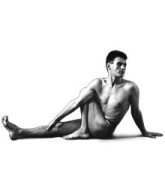 23. Marichyasana
23. Marichyasana
Contraindications and effects are the same as for А.М., only with that difference that work of the backbone has here another character; it is easier, but simultaneously more rigid.
Twisting to the right. Sit down on the floor, stretch out the left leg forward, bend the right at the knee so that calf and the back surface of the hip closely touched, the leg is literally folded in two, its heel touches the same buttock. Turn then to the right and bring the left hand behind the right leg bent at the knee and standing vertically. At the same time its foot stands on the floor near to the straight left leg, but not behind it as one usually does, remembering the first two variants of twisting. The left hand straight at the elbow presses slightly out – again to the left – the bent right leg, and the hand of this arm takes the straight left leg from outside approximately a little bit more below its knee. At the same time the bent right leg is more or less vertical, not falling to the left, otherwise the pose becomes pointless. Contraindications are identical with A.M.
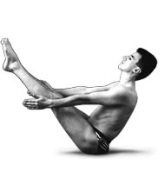
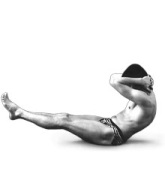 24, 25. Paripurna and Ardha Navasanas. In daily occurrence, arms and legs (and sometimes even the head) work more or less actively, but the prelum, as a rule, remains «the black hole». After forty the overwhelming part of the beautiful half of population (and the men are not much better) have almost atrophied muscles in this courtly area, therefore even their minimal training is very effective for viscera, general arousal, and cenesthesia, not to speak of appearance of the long ago forgotten waist.
24, 25. Paripurna and Ardha Navasanas. In daily occurrence, arms and legs (and sometimes even the head) work more or less actively, but the prelum, as a rule, remains «the black hole». After forty the overwhelming part of the beautiful half of population (and the men are not much better) have almost atrophied muscles in this courtly area, therefore even their minimal training is very effective for viscera, general arousal, and cenesthesia, not to speak of appearance of the long ago forgotten waist.
Putting the prelum in order, we harmonize it with periphery, "pulling up" the state of this area of the muscular corset to quality of the "rest" of the body. Besides, behind the abdominal wall (between the backbone and the stomach) there is the biggest (after brain and spinal cord) mass of the nervous substance – "solar plexus" on which these poses influence along with Nauli and Uddiana Bandha.
Thus, Paripurna Navasana or a «boat pose». Sit down on the floor, extend your legs forward. Lift them upwards from the floor, straight at the knees; having simultaneously leant back the trunk, balance, leaning against the coccygeal bone; at the same time the angle between the floor and the legs makes up 45 °; between the legs and the back – 90 °, between the back and the floor – 45 °. From one side the body looks like a right angle put on the edge.
It is necessary to use the given poses extremely accurately, if you have the pathological lordosis. Usually doctors advise to "exercise" the prelum and the back, but when the normal schema of the backbone is disturbed, it is impossible to make it in the safe way. Attempts in P.N. to lift the straight legs on a crossbeam or the Swedish wall are useless; the weight of the legs operates as a lever and injures the loin even more.
The following will be a competent thing: hang freely on the crossbeam, bend then the legs at the knees, pulling hips to the stomach, being rolled yourself up into a ball that the back remained round. One should perform it without trembling and extraordinary efforts; exactly so one can safely "exercise" one’s lordosis.
P.N. and A.N. differ by the supporting point: in Paripurna it is the coccygeal bone, in – А.N. the sacrum. If it is difficult in A.N. to keep hands behind the head, so you must extend them forward, parallel to the floor. The back in P.N. is whenever possible straight, in А.N. as round as possible. If in Paripurna it is necessary to keep hands parallel to the floor (or to lean against it if there is no balance), so after mastering А.N. hands are put behind the head. In Paripurna the binate rectus of the prelum is more loaded, in Ardha – basically oblique muscles.
If the abdominal muscles are weak, one should begin the practice of these poses with the minimal keeping and force them by no means. The prelum is a fine business if it is overloaded, so the award can become not dangerous, but rather nasty sensations.
P.N. and А.N. are forbidden, if there is a raised intracranial and eye pressure; lumbar lordosis, strong infringements of geometry of the body, noncompensated traumas of the backbone, inguinal hernia, women’ monthlies, acute states of internal organs, during the postoperative period, after cavitary and thoracal (on the thoracic cavity) operations, the expressed hypertension, blood disorders, organic heart disorders, the diaphragm hernia, the general weakness.
The optimum time of exposition of P.N. and А.N. is defined in an elementary way: we keep each of them, as they say, "as far as it would go", and then one should divide the actually received time by five, and it will be the most productive duration – twenty percent from the greatest possible.
The purpose of the given asanas is to strengthen and to develop the abdominal muscles; and consequently, we are interested in that exactly they were loaded. As soon as the endurance will exceed the optimum, abdominal muscles become disconnected; preservation of the form will be undertaken by the periphery, not relating to the prelum, for example, the anterior surface of hips, back, etc. At the same time the body starts to shake. In other words, if to keep the pose longer than the optimum time, there will be nothing good except for trembling, silly weariness, and probability to be overloaded.
But in limits of the best time (20 % from max.) one can competently involve (due to the conscious relaxation of periphery) those and only those muscles which interest us. The most widespread mistake of beginners during performance of the given asanas is involvement of a great number of "superfluous" muscles into them.
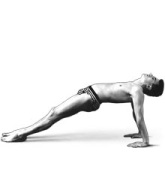 26. Purvottanasana. "Purva" in yoga terminology means "West" or the "front side of the body". The pose has no contraindications and is extremely simple; it strengthens hands, stretches shoulders and serves as compensation after asanas for the prelum.
26. Purvottanasana. "Purva" in yoga terminology means "West" or the "front side of the body". The pose has no contraindications and is extremely simple; it strengthens hands, stretches shoulders and serves as compensation after asanas for the prelum.
The only difficulty can be an enslaving of the humeral joints what prevents to curve the body as an arch upwards with placement of the feet on the floor (that can be interfered by a bad mobility of the ankle joint). But after regular practice all difficulties go away.
27. Urdhva Prasarita Padasana is also intended for development of the abdominal muscles; there are no special contraindications – except for lumbar lordosis and the general muscle weakness. If there is the last, at first it is necessary to lift upwards the legs bent at the knees. If the abdominal muscles are mediocre, the technics of performance will be the following: lie down on the back, bring upwards arms straight at the elbows, and put them on the floor behind the head, parallel to each other. Keep the legs together, strain them a little and stretch so that they remained straight at the knees.
The pose is performed in three stages: lift upwards legs on an exhalation, approximately at an angle of fifteen degrees from the floor and keep them so by a free (even if squeezed, but not stopped) breathing about ten seconds. Lift then them higher, approximately up to an angle of forty-five degrees, and fix them for about ten seconds, and, at last, having lifted them up to a right angle, remain so for half-minutes more.
From an outsider's viewpoint, it looks very simply, but there is one fineness. The matter is that, lifting the legs, you should – without dependence from an angle of their inclination – keep the loin pressed closely to the floor! It provides the maximal load of the abdominal muscles and is simultaneously the safety procedure for the lumbar spine. As we remember, it is forbidden in Paripurna and A.N. to bend the loin forward. The same requirement is fair for U.P.P., including those who do not have special problems with the loin.
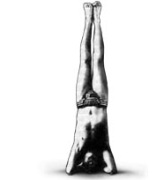 28, 29, 30. The turned poses – Sirshasana, Sarvangasana and Halasana – are forbidden for those who has problems with the neck, and also for physically weak people. Women after forty can start the turned only after one and a half years of regular practice of asanas, including necessarily the "standing".
28, 29, 30. The turned poses – Sirshasana, Sarvangasana and Halasana – are forbidden for those who has problems with the neck, and also for physically weak people. Women after forty can start the turned only after one and a half years of regular practice of asanas, including necessarily the "standing".
For the preliminary strengthening of the neck muscles there is a simple way, eliminating among other things a pathological instability of vertebrae, of not infrequent occurrence with children and less often with adults. It is rather painful and resists the exercise therapy. Traumatologists frankly advise to strengthen muscles, but there is a problem: to load the neck, one needs movement and when vertebrae leap easily out, any manipulations with the head lead to another trauma, so we get an exclusive circle.
But if the movement is inapplicable, one can use the weight of the head. And it is supposed to be done so: lie down on the stomach, the face down, and having put the forehead on the hands. Lift then the head literally on centimeter and keep it in the air. Preserve this position till fatigue in muscles of the neck is felt. It is the first exercise. The second: lie down supine and lift a little the nape from the floor, the face at the same time is turned strictly upwards, the position is kept up to unpleasant sensation in the forward side of the neck and muscles of the throat. The third position: lie on the right side, lift the head parallel to the floor and remain so that muscles of the left side of the neck would work. The fourth: perform the action similar to previous, lying on the left body side. In process of accustoming, one should repeat each exercise up to five times. These elementary techniques strengthen muscles of the neck in statics; vertebrae stabilization can be achieved for children during two-three months. The same method is suitable for preparation for the turned poses.
During their performance the following should strictly be observed:
– A full relaxation of the body and consciousness (especially in the headstand position);
– A minimum of muscular efforts;
– A free thoracic breathing (and not only the abdominal one!);
– A straight spine (in Sirshasana – completely, in Sarvangasana – except for the cervical spine, in Halasana – whenever possible the mid-spine should be straight, though there are some variants also with its maximal rounding – the back like a "wheel").
The "turned" are characteristic of that the body completely changes the position in relation to the vector of gravity. Maneuvering the time of exposition, it is possible to adjust the load on the left ventricle of the heart (the rate of diastolic relaxation increases – findings of R. Minvaleev, 1999, SPb) and the mitral valve. In passing these poses exert tranquilizing and sedative influence on psyche. By virtue of significance and also dangerous consequences which are entailed by the incorrect practice, we shall describe performance of these asanas in details.
Sirshasana (headstand pose) № 28, it is not recommended for mastering without a teacher, if one has cardiac diseases, strong backbone deformations, retinal detachment, glaucoma, epilepsy, the raised blood pressure, mental and blood diseases, or is after heavy craniocereberal traumas, and also in a bad shape . How much would not you have stood in the first attempt – some seconds or minutes – after that there should not be residual sensations in the neck, whose vertebrae are exposed to an unaccustomed compression. During placement of hands on the floor before performance of S., elbows form an angle of not more than ninety degrees (it happens frequently so: before entrance into the pose the angle is normal, but at the moment of repulsion from the floor, hands slide apart – it should be avoided). The middle of that area of the head on which it is necessary to stand, is traditionally located four fingers above hair border on the forehead (if it grows as usually). Or two fingers lower (in the direction to the face) from the highest point of the head when the face turned straightforward. The position of the head shown by Dhirendra Brahmachari in his book «Yogasana Vijnyana» (page 210) is in my opinion incorrect and dangerous!
At the beginning it is possible to stand on the head, pushing off from the floor by both legs or with the help of a not strong swing of one (the second is beforehand lifted upwards). Subsequently, when the back and the hands start "to get" weight of the underpinning, necessity for the swing disappears. It is most competent and safe to master S. in a corner of the room, standing bias so that it were possible if necessary to lean feet against the walls. One should never lean against the wall! Only at the very beginning of mastering S., otherwise you never learn to stand without a support! As soon as the balance is more or less mastered, one should stand into S. near the wall, but not touching it. If, standing in the middle of the room, you have suddenly lost balance and start to fall on the back, you must tuck as in cartwheel forward, which, actually, will at the same time turn out. If at the right time to unlink fingers interlaced into "lock", the cartwheel will be elementary.
Let us suppose, I have learned to stand into S. and to balance at the wall. In the beginning, touching it by the legs bent at the knees (the trunk and hips make one line), one should simply get used to the new position, though breathing should remain absolutely free. Then, leaning slightly toes of legs, bent at the knees, against the wall (the distance from the head up to the wall is equal to the length of hand area from fingertips up to the elbow; one should by no means place closely) and, putting one leg in the vertical line, straighten then the bent too, having taken it from the wall.
Sign that the body has caught axis (perpendicular to the floor) is easiness in the body; one feels so, as if the weight disappears what testifies correctness of the pose.
If the loin is too much caved in, and you stand as an arch (the pelvis and the legs are tumbled back) or the body not up to the end is straightened (legs are brought forward), there are at once appreciable efforts in the back and arms. When the vertical is automatically established, time of the endurance of Sirshasana will spontaneously start to increase. By no means, one can interfere in this process. As soon as the comfort gets broken, and the body starts to lose stability – it is necessary at once to go out from the pose. Beginners should not keep this pose for a long time and all the more by force. The "best" time, ordered by someone, is stuff and nonsense; one should stand only until there is easiness, immovability, and comfort. S. gives the optimum effect at endurance from ten up to (maximum!) twenty minutes; there is simply no sense of standing longer.
There should be in the given pose (when it is mastered):
– A full relaxation and comfort;
– Immovability (One can see on stabilograph only heart and breathing
work);
– Lack of obvious physical efforts;
– The closed eyes;
– Lack of warp, symmetry;
– Sensation of the full loss of weight;
– Absolutely quiet and imperceptible breathing;
– The condition of consciousness close to Shavasana.
When there is all this, the headstand is mastered. Usually after entrance into S., one can feel hot flash to the face, there is a pressure in it, and ears go slightly deaf. If everything is all right, in two – three minutes all this goes away. If not, it is necessary to go out from the pose, to lie on the back, to relax, and to analyze carefully your condition. Certainly, when in the beginning you stand some seconds, the pressure simply has no time to be leveled.
In ten minutes in S. there can be a sensation of blood outflow from feet – it is not necessary to wait, when it becomes unpleasant.
In all turned poses one should breathe only through the nose, as soon as there is the slightest sign of short wind or palpitation – go immediately out from the pose.
If after some time one feels in the neck a warp, it is impossible to correct it directly in the pose, it can end lamentably. One should either go out and then to stand again, or to raise oneself a little on hands so that the head has come off the surface – only then it is possible to change the head position.
After going out of Shavasana it is necessary to lie at once into Shavasana and to remain in it not less than half of time from duration of the pose.
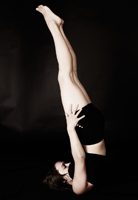 There are similar contraindications for Sarvangasana (№29), the shoulderstand. However, in the presence of not clear changes of the thyroid gland or its hyperfunction, S. should be performed only in such variant when the throat is not squeezed! It is necessary to exclude Jalanadhara bandha accompanying usually this pose (chin rest against the chest bone or the jugular fossa).
There are similar contraindications for Sarvangasana (№29), the shoulderstand. However, in the presence of not clear changes of the thyroid gland or its hyperfunction, S. should be performed only in such variant when the throat is not squeezed! It is necessary to exclude Jalanadhara bandha accompanying usually this pose (chin rest against the chest bone or the jugular fossa).
In total there are known four bandhas: Mula, Jalanadhara, Uddiana, and Maha (Traya bandha) – simultaneous keeping of the first three. M.B. is an isolated muscle contraction of the pelvic floor, and Uddiana is stomach retraction on a full exhalation. Bandhas are performed only with the straight back. The sequence of the Maha bandha is the following: Uddiana, Jalanadhara, and Mula.
How to remove D.B. from Sarvangasana? For this purpose it is necessary to perform the given pose, having placed shoulders and elbows on a platform made from blankets, mates, or everything. The point is that arms and shoulders were on this mini-platform, and the neck is like on the step formed by difference of heights, the nape is located on the floor. In such variant of S. the body is vertical, but the throat is not squeezed! The level difference between the platform and the floor is selected proceeding from the stiffness of the neck, its length, and thyroid gland condition.
Iyengar recommends applying this technique to everyone who starts to master poses of the "Candle" and the "Plough".
«The fact is», he spoke in 1989, «that zealous followers, looking at illustrations, see me performing these asanas on a solid surface and do the same. Consequently, on the upper part of their backbone a real corn is formed by which the faithful yogis recognize each other. And all this only because once one silly person (he pointed to himself) has used for demonstration of S. the flat floor. A yogi cannot have such corns, keep that in mind! »
If to look at № 234 in «Enlightenment of Yoga», so one can see that the thoracic spine by Iyengar is perpendicular to the floor. Therefore, the upper lobes in this position are not blocked, that is important! The form of thoracic spine of ninety-nine percent of beginners in S. is incorrect, as well as of Iyengar himself – № 236. One should master the "Candle" and the "Plough" for preservation of full-fledged breathing and the straight backbone (not to mention problems with the thyroid gland) only with some cushioning. To the extent of increasing of flexibility of the cervical spine, the height (thickness) of this artificial platform gradually decreases until the need for it disappears. By then the backbone will be straight, the breathing integral, and you will stay in S. freely and on any surface.
There is one more reason, according to which the backbone in S. and H. should be straight; it is necessary to weaken area of the solar plexus. Because of specific work of the cervical spine (from where a pair of sympathetic nerves, which are making active the diaphragm, goes out), it is more difficult to relax in the «Candle pose» than in the headstand.
That hands, by which the loin is propped up, do not crawl in S. away, one can apply a "prop" – a ring from a wide belt. If to fold it in two, the length should be equal to distance from the knuckles of the clinched fist up to the elbow. When you have risen in the "Candle pose", it is necessary to put this belt ring on hands so that it came to be behind the elbows, then they lose the tendency to creeping, and it is much easier to hold S.
In all three turned poses there are the two signs, speaking that the useful time of endurance has approached to the end: the natural respiratory impairment and the loss of the physical immovability; such unpleasant sensations, connected with blood flow, as for instance cold and tensive foot pain can join them.
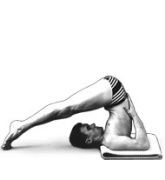 30. Halasana, the "Plough pose". It is mastered also with a cushioning. There are the same contraindications as to other turned poses; besides, the general condition of the back strongly influences performance of this pose. If it badly turns out with Pashimottanasana, then there will always be problems with H. too, in which the cervical spine is much stronger loaded than in two previous poses.
30. Halasana, the "Plough pose". It is mastered also with a cushioning. There are the same contraindications as to other turned poses; besides, the general condition of the back strongly influences performance of this pose. If it badly turns out with Pashimottanasana, then there will always be problems with H. too, in which the cervical spine is much stronger loaded than in two previous poses.
For beginners the technics is the same as for entrance into Sarvangasana. Having taken the accessible shape of H., it is necessary to estimate the degree of tension in the back, neck, and loin. In the beginning it is possible to lower the legs bent at the knees to the floor, if it is so easier. It is the bang for one, to relax and to breathe freely, even if being in the imperfect form, but with a minimum of sensations. As soon as they gain strength, one should go out from the pose, leaning hands against the floor in order not to fall sharply on the back.
If the backbone is "wooden", it is better not to try at all to put legs on the floor behind the head, but to put it, for example, on the seat of a chair. As the loin and the back adapt, the legs will start to sink below, and the height of the support can be diminished. Sometime the toes reach the floor, and then the support will not be necessary. With the lapse of time the legs will be straightened at the knees, and asana will get classical outlines. After that the back can be stretched further, the legs can be removed behind the head until angulation of the back to the floor exceeds ninety degrees, and become then blunt.
Then one can place the knees on the floor (Karnapidasana) and remove them on the floor from the head until the thorax lies literally down on the face. In other words, H. has a big range of development. The pose is typical also by the fact that back muscles always are completely relaxed here. If after performance of Halasana there are unfamiliar sensations (even not the pain!) in the neck, one should immediately leave the practice, as the overload of the cervical spine promises big troubles. If in ordinary life something stretches and shoots sporadically in the neck or the back, you have been already injured.
At incorrect performance of the turned poses, traumas sometimes are shown suddenly, as on a plane place, without any painful "adjustment of fire". Some days of an obscure weak background in the neck or between the shoulder-blades, and at any completely routine maneuver a pain in broad daylight as a knife goes into the back. The interscapular ligaments behave especially nasty, let them once "move out", and it is for a long time.
Besides, beginners commit a standard mistake: as soon as pain after trauma had left (and more often, not waiting its full disappearance), the enthusiast at once renews practice of the turned (or any other) poses. And, certainly, the trauma comes back again, and in the intensified variant. The lack of a sharp pain is not at all an indicator of the final recovery, for example, the broken hand, which knits, does not hurt since some moment. But who comes up with an idea to handle it as a healthy one?
Before to start anew practicing the pose, by the illiterate performing of which you had been traumatized, it is necessary to wait till symptoms of the trouble completely disappear. All this time one can and must do the rest of asanas, not touching the injured places. "To touch" a painful sensation is the same as to strip off a healed sore.
There is a law in Hatha Yoga: if the trauma has repeated, from the moment of the full termination of pain to the beginning of practice of the given asana as many days should pass as many they have passed from the moment of manifestation of the trauma till the full disappearance of pain and restrictions, caused by it.
I shall tell a real-life story, narrated to me else in the epoch of the USSR by the chief of functional diagnostics laboratory of the All-Union (now – All-Russia) Center of Vegetative Pathology (Moscow, street Rossolimo). Once, when the conversation turned to the headstand, he has told: «Do you remember a certain Voronin? He has even placed a whole series of articles on yoga in journal «Science and Life», in the beginning of 1980s. How did he manage to push it for printing, it passes all understanding. But essence is not in that. My friend, the leading neurosurgeon of city of Kishinev, knows now all local yogis without exception. It is, however, a joke, but daily some persons are actually brought in traumatology centres. Well, what physical forms have women, moreover after forty?! She has got up somehow on the head, and tries to stand, moreover there is no insurance… And then there is a subluxation of the cervical vertebrae. There were paralyses, and sometimes one broke the neck to death at all, what I only have not seen enough, my gosh! I personally would knock his little block of this Voronin off for disinformation! »
Well, what is it called: «In two weeks after the beginning of exercises one can start Shirshasana … »
What it's called, it had been clear then, and now – all the more, and I shall remind once again that with hyperfunction of thyroid gland one cannot touch area of the throat while performing Sarvangasana and Halasana.
Sequence of performance of the turned poses is always standard: Sarvangasana, Halasana. If they are done in succession, Shavasana in intervals is obligatory. If time of the headstand makes up from ten till fifteen minutes, so the relaxation before S. should be not less than three min. If the "Candle" lasts 10 minutes, it is necessary to have relaxation before Halasana as much. Five minutes of the «Plough pose» – two minutes of Shavasana, then it is necessary to make without fail Jathara Parivartanasana during three minutes to each side.
If (for some considerations) it is necessary to do the «headstand» after the "Candle" and "Plough poses", the interval between them (filled with other asanas) should make up not less than ten minutes.
Beginners frequently ask a ridiculous question: what is in yoga the most difficult? Iyengar had answered so: «The most difficult is to spread a rug and to sit down». Everything what prolongs life is cyclical: the use of water, food, breathing, sleep. The purpose of these actions is creation (preservation) of conditions for their repetition. We take a rest in order to work then, we work to get an opportunity to have a rest. Only what constantly recommences, survives. Why do women live on the average longer than men? Other things being equal, their organism possesses an additional rhythm – monthlies. If to do yoga daily, as breathing, it becomes the factor, prolonging youth.

